(function () {
var container = document.getElementById('popup2');
var content = document.getElementById('popup-content');
var closer = document.getElementById('popup-closer');
var overlay = new ol.Overlay({
element: container,
autoPan: true,
autoPanAnimation: {
duration: 250,
},
});
closer.onclick = function () {
overlay.setPosition(undefined);
closer.blur();
return false;
};
// PUNTI start ************************************************************************************
var style = [];
var vectorList_38 = [];
var iconList = [];
style['748'] = {
'LineString': new ol.style.Style({
stroke: new ol.style.Stroke({
color: 'black',
width: 3,
}),
}),
'MultiLineString': new ol.style.Style({
stroke: new ol.style.Stroke({
color: 'black',
width: 3,
}),
}),
};
// GPX start
var vectorgpx = new ol.layer.Vector({
name: 'Medium Trail',
description: '
',
source: new ol.source.Vector({
url: ['/files/gpx/Medio_a_piedi_chiusura_Bezzuglio.gpx'],
radius: 0,
format: new ol.format.GPX()
}),
style: function (feature) {
return style['748'][feature.getGeometry().getType()];
},
});
vectorList_38.push(vectorgpx);
var iconLayer = new ol.layer.Vector({
source: new ol.source.Vector({
features: iconList,
}),
});
vectorList_38.push(iconLayer);
var vectorList_28 = [];
var iconList = [];
style['766'] = {
'Point': new ol.style.Style({
image: new ol.style.Circle({
fill: new ol.style.Fill({
color: 'rgba(255,255,0,0.6)',
}),
radius: 10,
stroke: new ol.style.Stroke({
color: '#ff0',
width: 1,
}),
}),
}),
'LineString': new ol.style.Style({
stroke: new ol.style.Stroke({
color: '#e9b3ff',
width: 3,
}),
}),
'MultiLineString': new ol.style.Style({
stroke: new ol.style.Stroke({
color: '#e9b3ff',
width: 3,
}),
}),
};
// GPX start
var t = new ol.Feature({
geometry: new ol.geom.Point(ol.proj.fromLonLat([10.605524804399648, 45.65258234901218])),
name: 'Amateur fishermen of the Garda Union ',
description: 'In the Papermill Valley
Opening times:
- from 28/02/21 to 30/06/21 and from 01/09/21 to 03/10/21 open from friday to sunday (6.30-11.30 / 1pm-7pm)
- from 01/07/21 to 31/08/21 open daily (6.30-11.30 / 2 pm-7 pm)
License to be paid on the spot'
});
t.setStyle(
new ol.style.Style({
image: new ol.style.Circle({
fill: new ol.style.Fill({
color: '#e9b3ff'
}),
radius: 8,
stroke: new ol.style.Stroke({
color: '#000000',
width: 1,
}),
}),
}),
);
iconList.push(t);
var iconLayer = new ol.layer.Vector({
source: new ol.source.Vector({
features: iconList,
}),
});
vectorList_28.push(iconLayer);
var vectorList_16 = [];
var iconList = [];
style['698'] = {
'Point': new ol.style.Style({
image: new ol.style.Circle({
fill: new ol.style.Fill({
color: 'rgba(255,255,0,0.6)',
}),
radius: 10,
stroke: new ol.style.Stroke({
color: '#ff0',
width: 1,
}),
}),
}),
'LineString': new ol.style.Style({
stroke: new ol.style.Stroke({
color: '#00f93b',
width: 3,
}),
}),
'MultiLineString': new ol.style.Style({
stroke: new ol.style.Stroke({
color: '#00f93b',
width: 3,
}),
}),
};
// GPX start
var t = new ol.Feature({
geometry: new ol.geom.Point(ol.proj.fromLonLat([10.599563996507213, 45.634780380617904])),
name: 'Anchor of the \"Flottiglia MAS\"',
description: '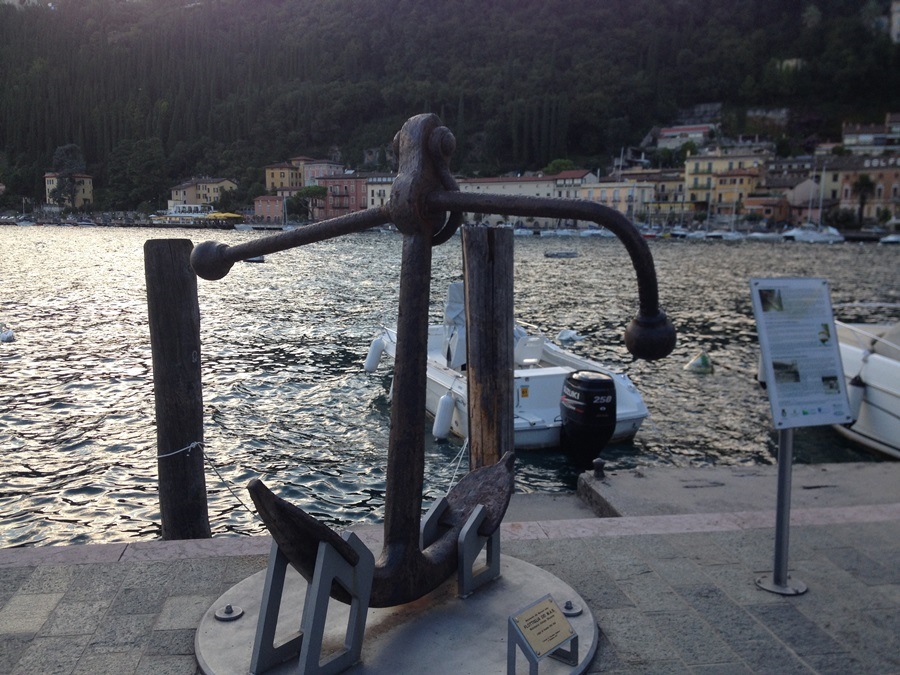
It’s a 478kg anchor pulled out from the bottom of the lake in 2011. It was used to anchor a big circular buoy where in 1918 3 MAS (torpedo-armed motorboat) were moored, sent by the Navy the last year of WWI in order to defend from enemy attacks, since the area was considered a front line zone. It commemorates the fallen of the Navy'
});
t.setStyle(
new ol.style.Style({
image: new ol.style.Circle({
fill: new ol.style.Fill({
color: '#00f93b'
}),
radius: 8,
stroke: new ol.style.Stroke({
color: '#000000',
width: 1,
}),
}),
}),
);
iconList.push(t);
style['735'] = {
'Point': new ol.style.Style({
image: new ol.style.Circle({
fill: new ol.style.Fill({
color: 'rgba(255,255,0,0.6)',
}),
radius: 10,
stroke: new ol.style.Stroke({
color: '#ff0',
width: 1,
}),
}),
}),
'LineString': new ol.style.Style({
stroke: new ol.style.Stroke({
color: '#00f93b',
width: 3,
}),
}),
'MultiLineString': new ol.style.Style({
stroke: new ol.style.Stroke({
color: '#00f93b',
width: 3,
}),
}),
};
// GPX start
var t = new ol.Feature({
geometry: new ol.geom.Point(ol.proj.fromLonLat([10.599601, 45.635236])),
name: 'Monumento of St. Ercolano',
description: '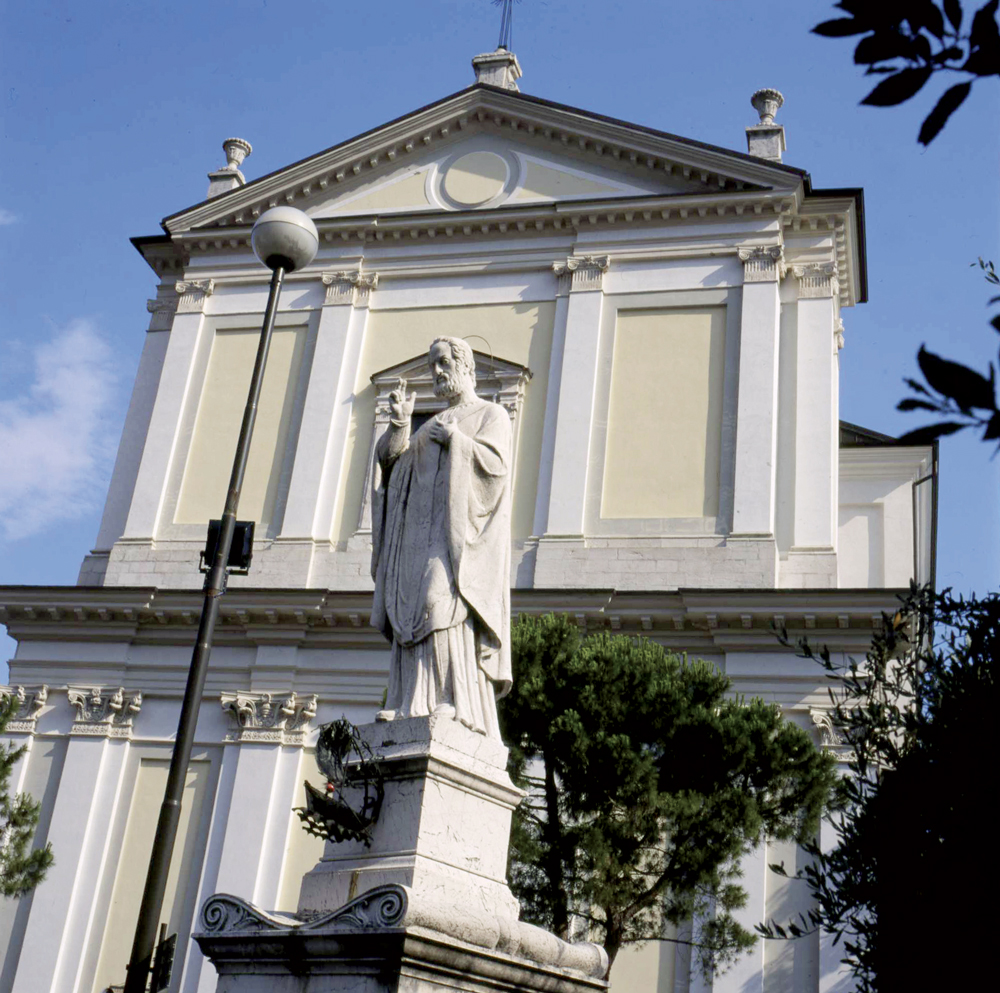
The marble statue is dedicated to St. Ercolano, the patron saint of Maderno and also of the Riviera, celebrated on August 12. It was built in 1838 by the sculptor Cesare Nesti and Adamo Tagliani. It was the result of a promise made by the people of Maderno, when an epidemic of cholera broke out in July 1836.
They asked to S. Ercolano to protect the population. In September the epidemic was over and the statue was then built
'
});
t.setStyle(
new ol.style.Style({
image: new ol.style.Circle({
fill: new ol.style.Fill({
color: '#00f93b'
}),
radius: 8,
stroke: new ol.style.Stroke({
color: '#000000',
width: 1,
}),
}),
}),
);
iconList.push(t);
style['718'] = {
'Point': new ol.style.Style({
image: new ol.style.Circle({
fill: new ol.style.Fill({
color: 'rgba(255,255,0,0.6)',
}),
radius: 10,
stroke: new ol.style.Stroke({
color: '#ff0',
width: 1,
}),
}),
}),
'LineString': new ol.style.Style({
stroke: new ol.style.Stroke({
color: '#00f93b',
width: 3,
}),
}),
'MultiLineString': new ol.style.Style({
stroke: new ol.style.Stroke({
color: '#00f93b',
width: 3,
}),
}),
};
// GPX start
var t = new ol.Feature({
geometry: new ol.geom.Point(ol.proj.fromLonLat([10.598902, 45.635768])),
name: 'The Lion and S. Marco square',
description: '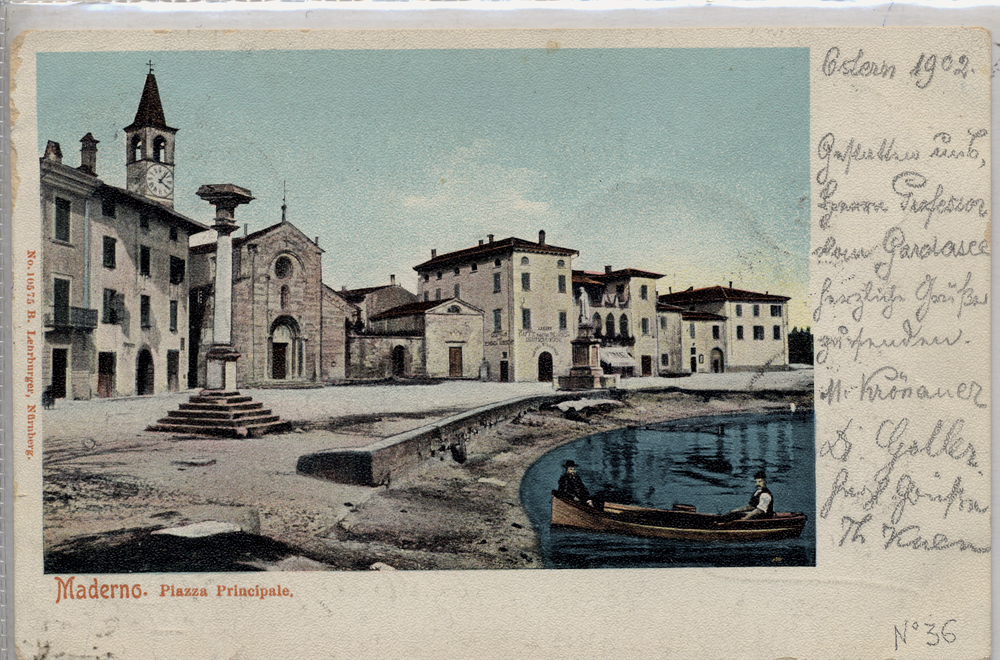
The column, symbol of the Serenissima Republic of Venice was built in 1610 in front of the old town hall of Maderno. On the base the are low reliefs representing Saint Andrew, patron saint of Maderno, and Saint Herculanums, patron saint of the entire Riviera. According to the local tradition, when the Republic of Venice fell in 1797, the original stone lion was thrown into the giulf. The current bronze sculpture was made in 1902 by Ettore Ximenes (Palermo, 1855 – Rome, 1926) who donated it to the community of Maderno.'
});
t.setStyle(
new ol.style.Style({
image: new ol.style.Circle({
fill: new ol.style.Fill({
color: '#00f93b'
}),
radius: 8,
stroke: new ol.style.Stroke({
color: '#000000',
width: 1,
}),
}),
}),
);
iconList.push(t);
var iconLayer = new ol.layer.Vector({
source: new ol.source.Vector({
features: iconList,
}),
});
vectorList_16.push(iconLayer);
var vectorList_36 = [];
var iconList = [];
style['756'] = {
'Point': new ol.style.Style({
image: new ol.style.Circle({
fill: new ol.style.Fill({
color: 'rgba(255,255,0,0.6)',
}),
radius: 10,
stroke: new ol.style.Stroke({
color: '#ff0',
width: 1,
}),
}),
}),
'LineString': new ol.style.Style({
stroke: new ol.style.Stroke({
color: '#235ba0',
width: 3,
}),
}),
'MultiLineString': new ol.style.Style({
stroke: new ol.style.Stroke({
color: '#235ba0',
width: 3,
}),
}),
};
// GPX start
var t = new ol.Feature({
geometry: new ol.geom.Point(ol.proj.fromLonLat([10.606914171707567, 45.63114532983328])),
name: 'ASD Remiera Toscolano',
description: 'The rowing club organizes courses throughout the year, for kids and adults, and some events such as Dragon Boat, Gardalonga and S. Martino festival'
});
t.setStyle(
new ol.style.Style({
image: new ol.style.Circle({
fill: new ol.style.Fill({
color: '#235ba0'
}),
radius: 8,
stroke: new ol.style.Stroke({
color: '#000000',
width: 1,
}),
}),
}),
);
iconList.push(t);
var iconLayer = new ol.layer.Vector({
source: new ol.source.Vector({
features: iconList,
}),
});
vectorList_36.push(iconLayer);
var vectorList_23 = [];
var iconList = [];
style['732'] = {
'Point': new ol.style.Style({
image: new ol.style.Circle({
fill: new ol.style.Fill({
color: 'rgba(255,255,0,0.6)',
}),
radius: 10,
stroke: new ol.style.Stroke({
color: '#ff0',
width: 1,
}),
}),
}),
'LineString': new ol.style.Style({
stroke: new ol.style.Stroke({
color: '#385e39',
width: 3,
}),
}),
'MultiLineString': new ol.style.Style({
stroke: new ol.style.Stroke({
color: '#385e39',
width: 3,
}),
}),
};
// GPX start
var t = new ol.Feature({
geometry: new ol.geom.Point(ol.proj.fromLonLat([10.600225465178168, 45.63463308569395])),
name: 'Bell Tower (Ex Castle)',
description: 'It\'s the only part remaining of the big castle, probably built during the VIII Century. It had a double row of curtain walls, surrounded by a moat, with 4 towers. On the side of the square there was the drawbridge.Inside of the castle, that faced a wide courtyard, there was a Palace that from 1336 was the seat of the administration of the Comunità di Riviera and then residence of the Vicar of the Magnifica Patria. The palace and the castle were severely dameged by a fire in 1645 and demolished (except the tower) in order to build the parish church a century after.
'
});
t.setStyle(
new ol.style.Style({
image: new ol.style.Circle({
fill: new ol.style.Fill({
color: '#385e39'
}),
radius: 8,
stroke: new ol.style.Stroke({
color: '#000000',
width: 1,
}),
}),
}),
);
iconList.push(t);
style['730'] = {
'Point': new ol.style.Style({
image: new ol.style.Circle({
fill: new ol.style.Fill({
color: 'rgba(255,255,0,0.6)',
}),
radius: 10,
stroke: new ol.style.Stroke({
color: '#ff0',
width: 1,
}),
}),
}),
'LineString': new ol.style.Style({
stroke: new ol.style.Stroke({
color: '#385e39',
width: 3,
}),
}),
'MultiLineString': new ol.style.Style({
stroke: new ol.style.Stroke({
color: '#385e39',
width: 3,
}),
}),
};
// GPX start
var t = new ol.Feature({
geometry: new ol.geom.Point(ol.proj.fromLonLat([10.609055700445758, 45.64140801163121])),
name: 'The old Bridge',
description: 'So called to distinguish it from the new bridge built in 1908, it dates back to the early 16th Century and its construction was ordered in 1497, payed by the Magnifica Patria. They say that up until mid 19th Century on the parapet towards the mount there were two niches, one with a fragment of a sculpture representing a woman with a tiara.
Here there was Contrada Ponte (bridge), the first contrada of Toscolano for those arriving from Maderno and it was crossed by the Strada Regia that continued in via Trento.
Before the contruction of the bridge people crossed the river through fords
'
});
t.setStyle(
new ol.style.Style({
image: new ol.style.Circle({
fill: new ol.style.Fill({
color: '#385e39'
}),
radius: 8,
stroke: new ol.style.Stroke({
color: '#000000',
width: 1,
}),
}),
}),
);
iconList.push(t);
style['710'] = {
'Point': new ol.style.Style({
image: new ol.style.Circle({
fill: new ol.style.Fill({
color: 'rgba(255,255,0,0.6)',
}),
radius: 10,
stroke: new ol.style.Stroke({
color: '#ff0',
width: 1,
}),
}),
}),
'LineString': new ol.style.Style({
stroke: new ol.style.Stroke({
color: '#385e39',
width: 3,
}),
}),
'MultiLineString': new ol.style.Style({
stroke: new ol.style.Stroke({
color: '#385e39',
width: 3,
}),
}),
};
// GPX start
var t = new ol.Feature({
geometry: new ol.geom.Point(ol.proj.fromLonLat([10.61918884246249, 45.64606058703979])),
name: 'The Toscolano Harbor',
description: '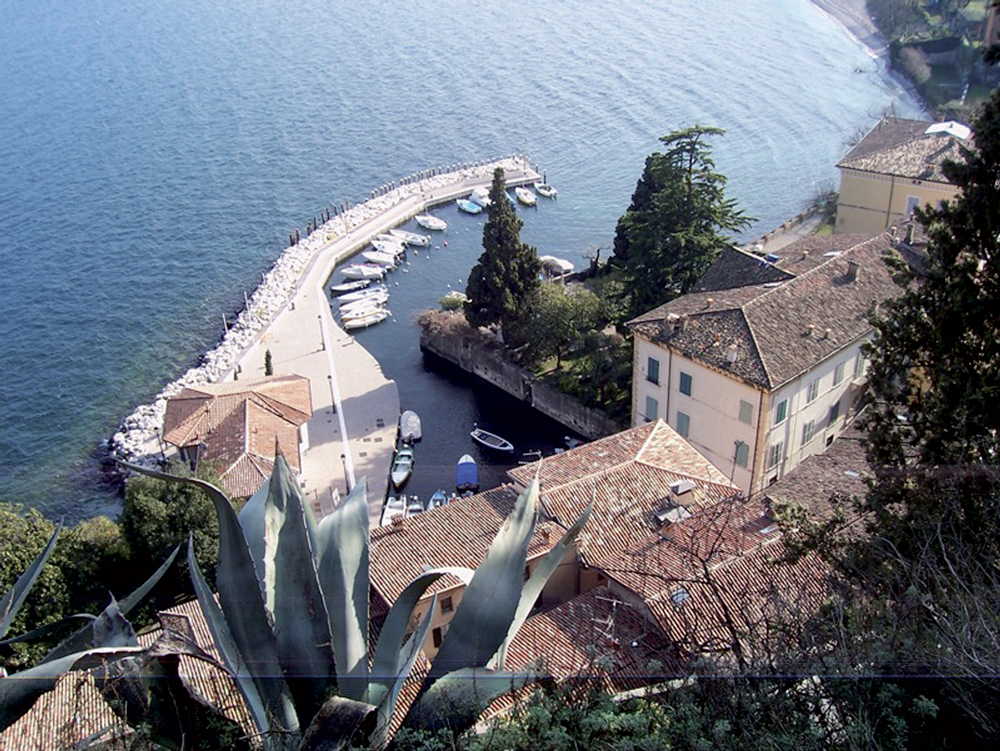
Charming and quiet, the small harbour is surrounded by ancient buildings once inhabited by noble families, such as the Delai Palace on the left of the square, that dates back to the XVII Century and preserves beautiful frescoes. Between the 15th and the 17th century it was a busy distribution centre of goods and iron, where the boats came from and went to Venice.
From the harbour of Toscolano you can admire what remains of one of the many lemon gardens which dotted the territory of Toscolano until the beginning of the XX century and represented a major source of local income. Citrus fruits grown, especially lemons, were exported across Europe. The cultivation was probably introduced by Franciscan friars in the thirteenth century and abandoned in the early twentieth century because it was no longer competitive.
'
});
t.setStyle(
new ol.style.Style({
image: new ol.style.Circle({
fill: new ol.style.Fill({
color: '#385e39'
}),
radius: 8,
stroke: new ol.style.Stroke({
color: '#000000',
width: 1,
}),
}),
}),
);
iconList.push(t);
style['703'] = {
'Point': new ol.style.Style({
image: new ol.style.Circle({
fill: new ol.style.Fill({
color: 'rgba(255,255,0,0.6)',
}),
radius: 10,
stroke: new ol.style.Stroke({
color: '#ff0',
width: 1,
}),
}),
}),
'LineString': new ol.style.Style({
stroke: new ol.style.Stroke({
color: '#385e39',
width: 3,
}),
}),
'MultiLineString': new ol.style.Style({
stroke: new ol.style.Stroke({
color: '#385e39',
width: 3,
}),
}),
};
// GPX start
var t = new ol.Feature({
geometry: new ol.geom.Point(ol.proj.fromLonLat([10.616500971707813, 45.6408105071995])),
name: 'The Toscolano Papermill',
description: '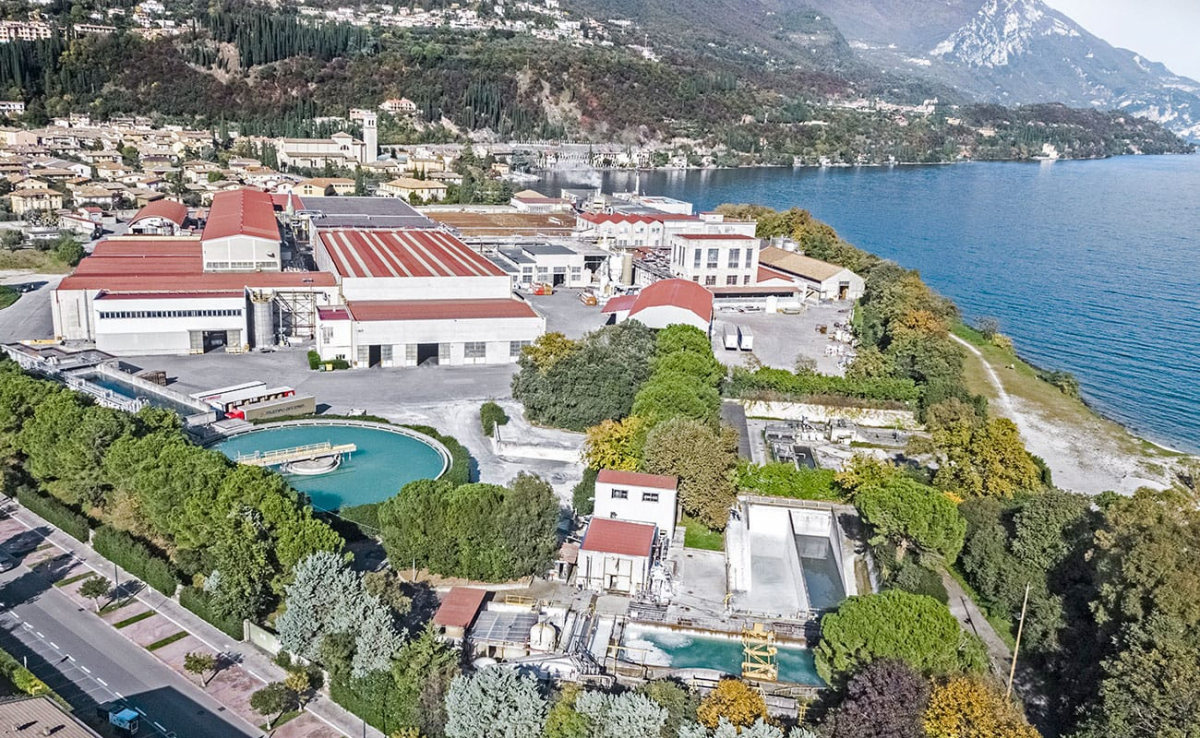
The papermill of Toscolano was built thanks to Andrea Maffizzoli and the Maffizzoli Brothers Company who were already the owners of some papermills in the Valley and they wanted to build a new papermill on the lakeshore, in Capra, equipped with the most modern machinery for paper production. The construction begun in 1906 and the papermill officially opened on March 19th 1910. In 1927 the 5 Maffizzoli’s papermills had 1100 workers. In 1945 the building in Toscolano was bombed and semi destroyed by the Allied.
From 1989 has been part of the Marchi Group and from 2007 of the Burgo Group. The papermill hires now 370 workers'
});
t.setStyle(
new ol.style.Style({
image: new ol.style.Circle({
fill: new ol.style.Fill({
color: '#385e39'
}),
radius: 8,
stroke: new ol.style.Stroke({
color: '#000000',
width: 1,
}),
}),
}),
);
iconList.push(t);
var iconLayer = new ol.layer.Vector({
source: new ol.source.Vector({
features: iconList,
}),
});
vectorList_23.push(iconLayer);
var vectorList_27 = [];
var iconList = [];
style['739'] = {
'Point': new ol.style.Style({
image: new ol.style.Circle({
fill: new ol.style.Fill({
color: 'rgba(255,255,0,0.6)',
}),
radius: 10,
stroke: new ol.style.Stroke({
color: '#ff0',
width: 1,
}),
}),
}),
'LineString': new ol.style.Style({
stroke: new ol.style.Stroke({
color: '#e7ceb0',
width: 3,
}),
}),
'MultiLineString': new ol.style.Style({
stroke: new ol.style.Stroke({
color: '#e7ceb0',
width: 3,
}),
}),
};
// GPX start
var t = new ol.Feature({
geometry: new ol.geom.Point(ol.proj.fromLonLat([10.600376275448935, 45.63626531979006])),
name: 'Benamati Palace',
description: '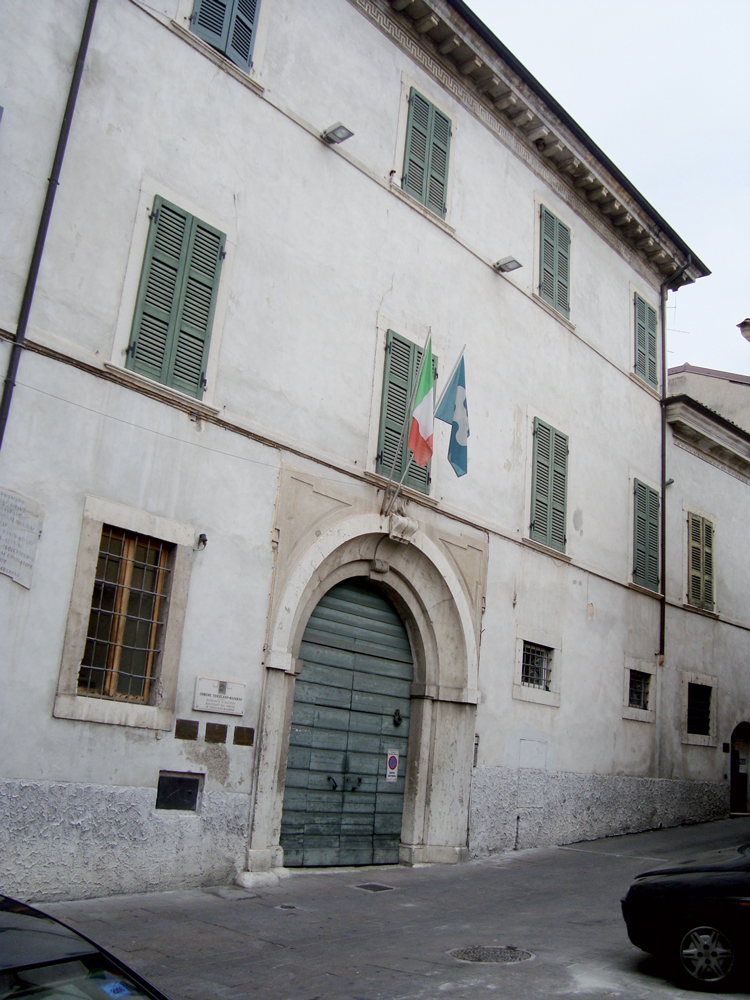
Palazzo Benamati was designated by his owner, Don Cristoforo Benamati, who died in 1799, as the seat of a school for children from Maderno. It was the seat of the elementary school until 1927 and kindergarten until the 70s. Today it is the location for cultural events, shows and concerts.
Inside, the big hall is dedicated to Andrea Celesti.
Traces of the 18th Century decorations are stil visible today.
The painting in the hall comes from Villa Serraglio and it represents a burning city
'
});
t.setStyle(
new ol.style.Style({
image: new ol.style.Circle({
fill: new ol.style.Fill({
color: '#e7ceb0'
}),
radius: 8,
stroke: new ol.style.Stroke({
color: '#000000',
width: 1,
}),
}),
}),
);
iconList.push(t);
style['727'] = {
'Point': new ol.style.Style({
image: new ol.style.Circle({
fill: new ol.style.Fill({
color: 'rgba(255,255,0,0.6)',
}),
radius: 10,
stroke: new ol.style.Stroke({
color: '#ff0',
width: 1,
}),
}),
}),
'LineString': new ol.style.Style({
stroke: new ol.style.Stroke({
color: '#e7ceb0',
width: 3,
}),
}),
'MultiLineString': new ol.style.Style({
stroke: new ol.style.Stroke({
color: '#e7ceb0',
width: 3,
}),
}),
};
// GPX start
var t = new ol.Feature({
geometry: new ol.geom.Point(ol.proj.fromLonLat([10.600610283346228, 45.63753490873119])),
name: 'Bulgheroni Palace',
description: '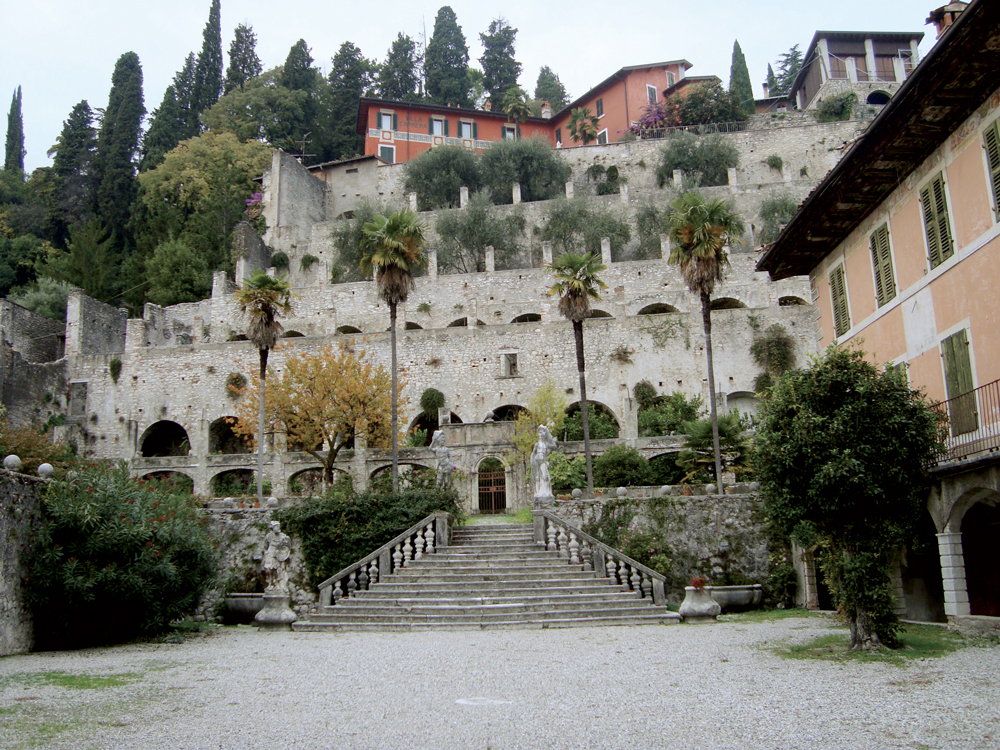
Palazzo Bulgheroni, also known as Villa Lucia, belongs to an elegant historical complex surrounded by a wide wall surmonted by big stone balls with a small tower in its corner. The big ashlar gate opens on a garden towards which the villa is faced to and a scenographic staircase with satues, vats and mascarons that leads to the terraces of an old lemon garden. The palace has an interesting frescoed frieze beneath the roof with putti and mythological figures. The plan of the building dates back to the XVII C. In 1707 the property beloged to the counts Rizzardi, whose emblems are on the shield of one of the statues on the staircase. From the end of the XIX C, it belonged to the Bulgheroni Family.'
});
t.setStyle(
new ol.style.Style({
image: new ol.style.Circle({
fill: new ol.style.Fill({
color: '#e7ceb0'
}),
radius: 8,
stroke: new ol.style.Stroke({
color: '#000000',
width: 1,
}),
}),
}),
);
iconList.push(t);
style['771'] = {
'Point': new ol.style.Style({
image: new ol.style.Circle({
fill: new ol.style.Fill({
color: 'rgba(255,255,0,0.6)',
}),
radius: 10,
stroke: new ol.style.Stroke({
color: '#ff0',
width: 1,
}),
}),
}),
'LineString': new ol.style.Style({
stroke: new ol.style.Stroke({
color: '#e7ceb0',
width: 3,
}),
}),
'MultiLineString': new ol.style.Style({
stroke: new ol.style.Stroke({
color: '#e7ceb0',
width: 3,
}),
}),
};
// GPX start
var t = new ol.Feature({
geometry: new ol.geom.Point(ol.proj.fromLonLat([10.605244, 45.652062])),
name: 'Maffizzoli Palace',
description: '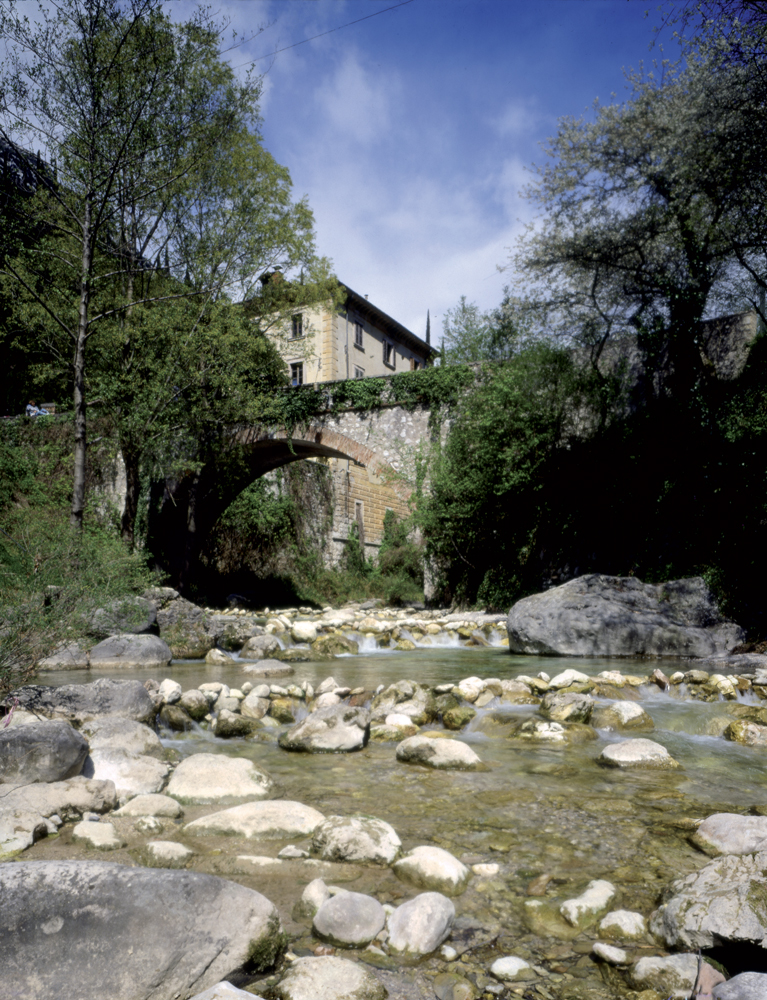
Property of the Maffizzoli family, famous paper makers. It was built on the side of the river at the entrance of Maina Superiore, that was the main paper production centre at the end of the 19th Century'
});
t.setStyle(
new ol.style.Style({
image: new ol.style.Circle({
fill: new ol.style.Fill({
color: '#e7ceb0'
}),
radius: 8,
stroke: new ol.style.Stroke({
color: '#000000',
width: 1,
}),
}),
}),
);
iconList.push(t);
var iconLayer = new ol.layer.Vector({
source: new ol.source.Vector({
features: iconList,
}),
});
vectorList_27.push(iconLayer);
var vectorList_35 = [];
var iconList = [];
style['757'] = {
'Point': new ol.style.Style({
image: new ol.style.Circle({
fill: new ol.style.Fill({
color: 'rgba(255,255,0,0.6)',
}),
radius: 10,
stroke: new ol.style.Stroke({
color: '#ff0',
width: 1,
}),
}),
}),
'LineString': new ol.style.Style({
stroke: new ol.style.Stroke({
color: '#609036',
width: 3,
}),
}),
'MultiLineString': new ol.style.Style({
stroke: new ol.style.Stroke({
color: '#609036',
width: 3,
}),
}),
};
// GPX start
var t = new ol.Feature({
geometry: new ol.geom.Point(ol.proj.fromLonLat([10.636869817742053, 45.66279674990764])),
name: 'Bogliaco Golf Resort',
description: '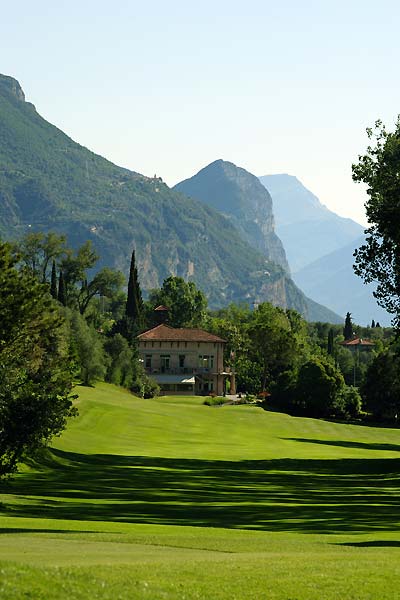
The third oldest golf course in Italy, situated in a hollow that, thanks to its raised position, allows for a beautiful view of the Lake Garda. The resort is open all year round, thanks to mild winter days The golf course is surrounded by lemon trees and centuries old olive trees, water ponds and the typical mediterranean vegetation The PAR 70 course has 18 holes, a driving range, a Club House with lounge area and restaurant, apartments, and a 10-room Lodge.'
});
t.setStyle(
new ol.style.Style({
image: new ol.style.Circle({
fill: new ol.style.Fill({
color: '#609036'
}),
radius: 8,
stroke: new ol.style.Stroke({
color: '#000000',
width: 1,
}),
}),
}),
);
iconList.push(t);
var iconLayer = new ol.layer.Vector({
source: new ol.source.Vector({
features: iconList,
}),
});
vectorList_35.push(iconLayer);
var vectorList_a = [];
var iconList = [];
style['675'] = {
'Point': new ol.style.Style({
image: new ol.style.Circle({
fill: new ol.style.Fill({
color: 'rgba(255,255,0,0.6)',
}),
radius: 10,
stroke: new ol.style.Stroke({
color: '#ff0',
width: 1,
}),
}),
}),
'LineString': new ol.style.Style({
stroke: new ol.style.Stroke({
color: 'red',
width: 3,
}),
}),
'MultiLineString': new ol.style.Style({
stroke: new ol.style.Stroke({
color: 'red',
width: 3,
}),
}),
};
// GPX start
var t = new ol.Feature({
geometry: new ol.geom.Point(ol.proj.fromLonLat([10.608602239785, 45.656037132268])),
name: 'Caneto [Cané]',
description: '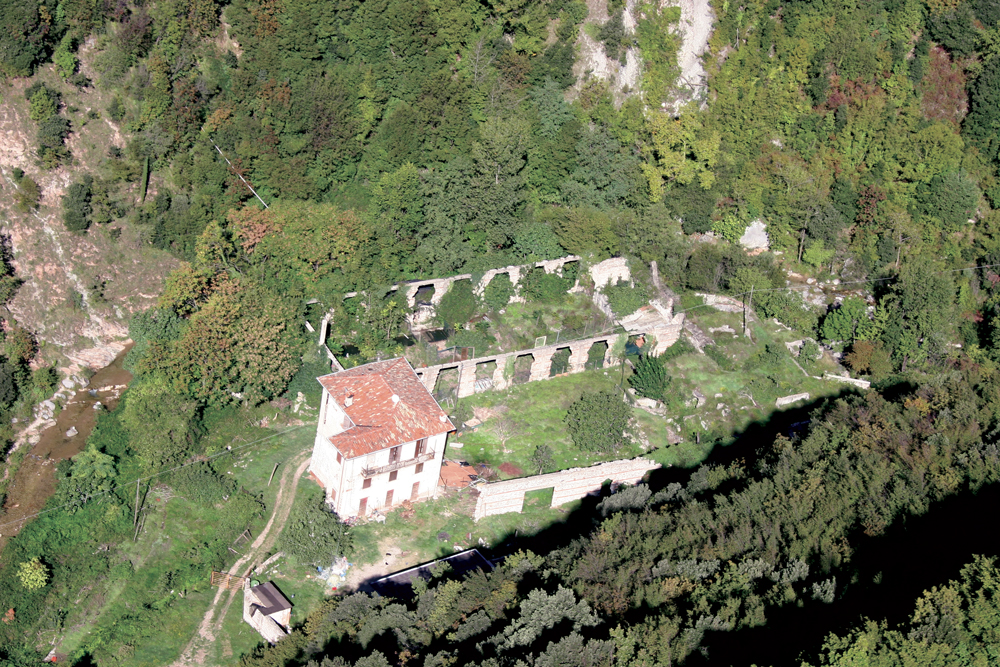
The first info about the existence of papermills in this valley dates back to the end of the XV Century. During the XVIII Century this locality, property of the Zuanelli family, was damaged by a flood. During the first half of the XIX Century the Simonellis restored some of the buildings and built a new paper mill. At the end of the century the Avanzini family, the last owner, added an oil mill.
'
});
t.setStyle(
new ol.style.Style({
image: new ol.style.Circle({
fill: new ol.style.Fill({
color: 'red'
}),
radius: 8,
stroke: new ol.style.Stroke({
color: '#000000',
width: 1,
}),
}),
}),
);
iconList.push(t);
style['676'] = {
'Point': new ol.style.Style({
image: new ol.style.Circle({
fill: new ol.style.Fill({
color: 'rgba(255,255,0,0.6)',
}),
radius: 10,
stroke: new ol.style.Stroke({
color: '#ff0',
width: 1,
}),
}),
}),
'LineString': new ol.style.Style({
stroke: new ol.style.Stroke({
color: 'red',
width: 3,
}),
}),
'MultiLineString': new ol.style.Style({
stroke: new ol.style.Stroke({
color: 'red',
width: 3,
}),
}),
};
// GPX start
var t = new ol.Feature({
geometry: new ol.geom.Point(ol.proj.fromLonLat([10.610224140363, 45.658316502998])),
name: 'Contrada [Cuntràda]',
description: '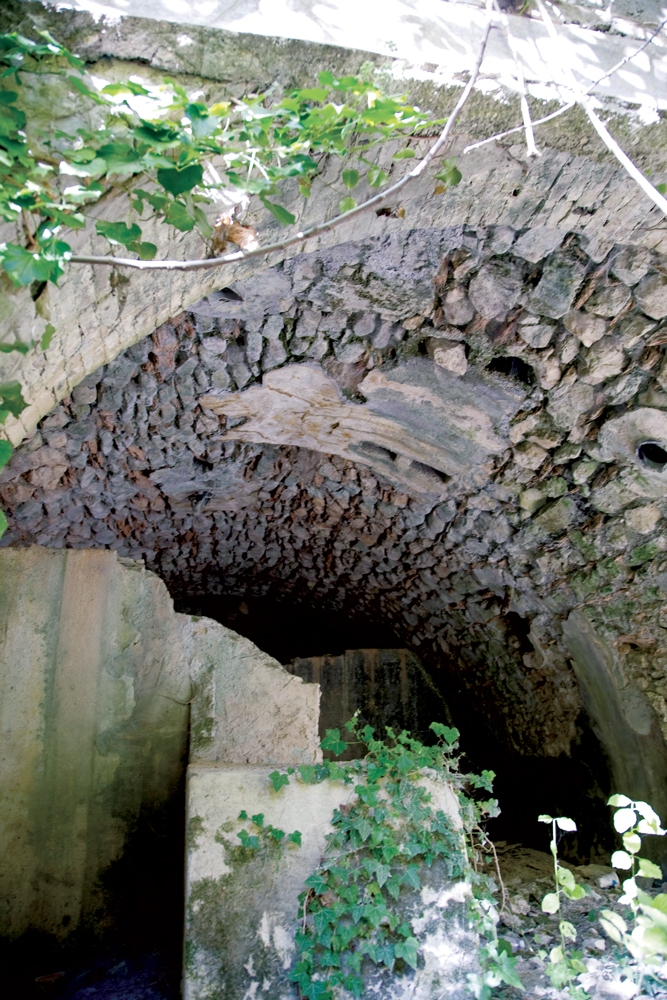
Now reduced to a narrow mule track, the last part of the path going up the valley is studded with vaults of rooms buried by vegetation, and with more recent structure in reinforced concrete goint towards the river. These ruins were parts of the productive settlement of Contrada, that once occupied the final part of the valley, between Luseti and Lume.
WARNING The papermill Valley is closed from Luseti to Covoli'
});
t.setStyle(
new ol.style.Style({
image: new ol.style.Circle({
fill: new ol.style.Fill({
color: 'red'
}),
radius: 8,
stroke: new ol.style.Stroke({
color: '#000000',
width: 1,
}),
}),
}),
);
iconList.push(t);
style['759'] = {
'Point': new ol.style.Style({
image: new ol.style.Circle({
fill: new ol.style.Fill({
color: 'rgba(255,255,0,0.6)',
}),
radius: 10,
stroke: new ol.style.Stroke({
color: '#ff0',
width: 1,
}),
}),
}),
'LineString': new ol.style.Style({
stroke: new ol.style.Stroke({
color: 'red',
width: 3,
}),
}),
'MultiLineString': new ol.style.Style({
stroke: new ol.style.Stroke({
color: 'red',
width: 3,
}),
}),
};
// GPX start
var t = new ol.Feature({
geometry: new ol.geom.Point(ol.proj.fromLonLat([10.605708047617185, 45.63156830503782])),
name: 'Ex Horse riding Ground',
description: '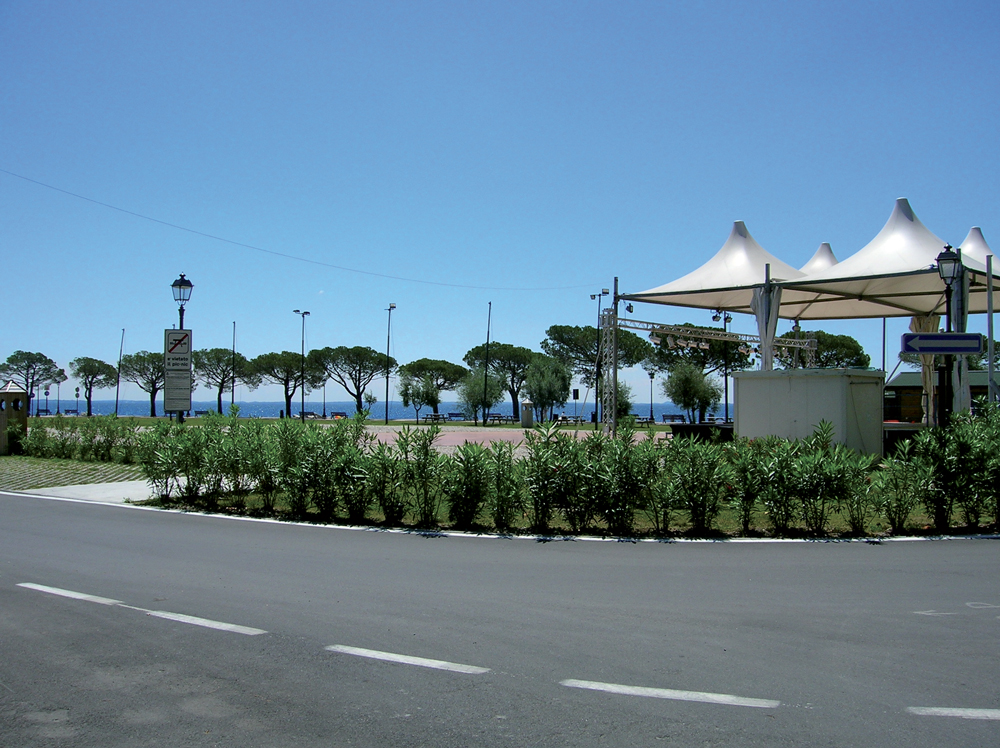
The former Horse riding ground is now a beautiful grass field, a stone’s throw away from the lake, perfect for chilling out during summer.
On summer evenings the filed is the location for events such as concerts and shows. '
});
t.setStyle(
new ol.style.Style({
image: new ol.style.Circle({
fill: new ol.style.Fill({
color: 'red'
}),
radius: 8,
stroke: new ol.style.Stroke({
color: '#000000',
width: 1,
}),
}),
}),
);
iconList.push(t);
style['678'] = {
'Point': new ol.style.Style({
image: new ol.style.Circle({
fill: new ol.style.Fill({
color: 'rgba(255,255,0,0.6)',
}),
radius: 10,
stroke: new ol.style.Stroke({
color: '#ff0',
width: 1,
}),
}),
}),
'LineString': new ol.style.Style({
stroke: new ol.style.Stroke({
color: 'red',
width: 3,
}),
}),
'MultiLineString': new ol.style.Style({
stroke: new ol.style.Stroke({
color: 'red',
width: 3,
}),
}),
};
// GPX start
var t = new ol.Feature({
geometry: new ol.geom.Point(ol.proj.fromLonLat([10.610017, 45.657481])),
name: 'Gatto [Gat]',
description: '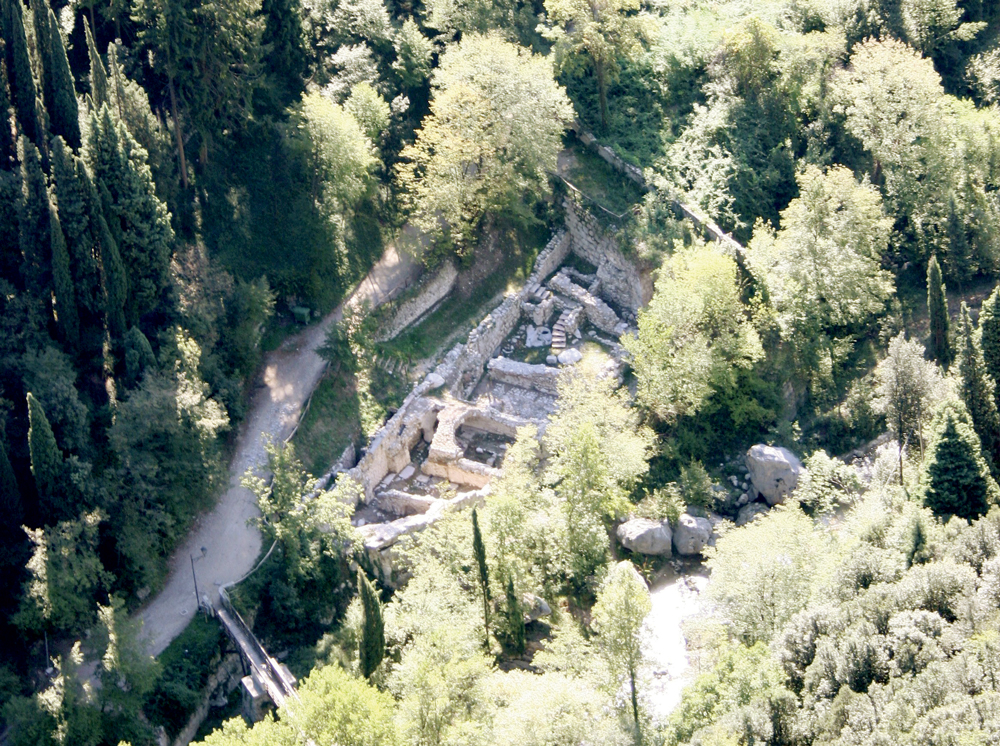
The locality at the end of the road, before the bridge that crosses the river, is today known as Gatto (Gàt), its name may derives from its owner epithet.
Since 2002 an archaeological excavation brought to light the semibasement of a building, origanally structured on several storeys and with a channel on its west side. The oldest ruins date back to the XV Century.
During the 1800s some of the spaces were abandoned and a stone bridge was built on the ruins. This bridge was then rebuilt with the construction of the new road between 1871 and 1878, and it finally fell down due to a flood. The paper mill was completely abandoned at the end of the XIX Century.'
});
t.setStyle(
new ol.style.Style({
image: new ol.style.Circle({
fill: new ol.style.Fill({
color: 'red'
}),
radius: 8,
stroke: new ol.style.Stroke({
color: '#000000',
width: 1,
}),
}),
}),
);
iconList.push(t);
style['760'] = {
'Point': new ol.style.Style({
image: new ol.style.Circle({
fill: new ol.style.Fill({
color: 'rgba(255,255,0,0.6)',
}),
radius: 10,
stroke: new ol.style.Stroke({
color: '#ff0',
width: 1,
}),
}),
}),
'LineString': new ol.style.Style({
stroke: new ol.style.Stroke({
color: 'red',
width: 3,
}),
}),
'MultiLineString': new ol.style.Style({
stroke: new ol.style.Stroke({
color: 'red',
width: 3,
}),
}),
};
// GPX start
var t = new ol.Feature({
geometry: new ol.geom.Point(ol.proj.fromLonLat([10.59943122329191, 45.635349297513734])),
name: 'Lakeside Zanardelli',
description: '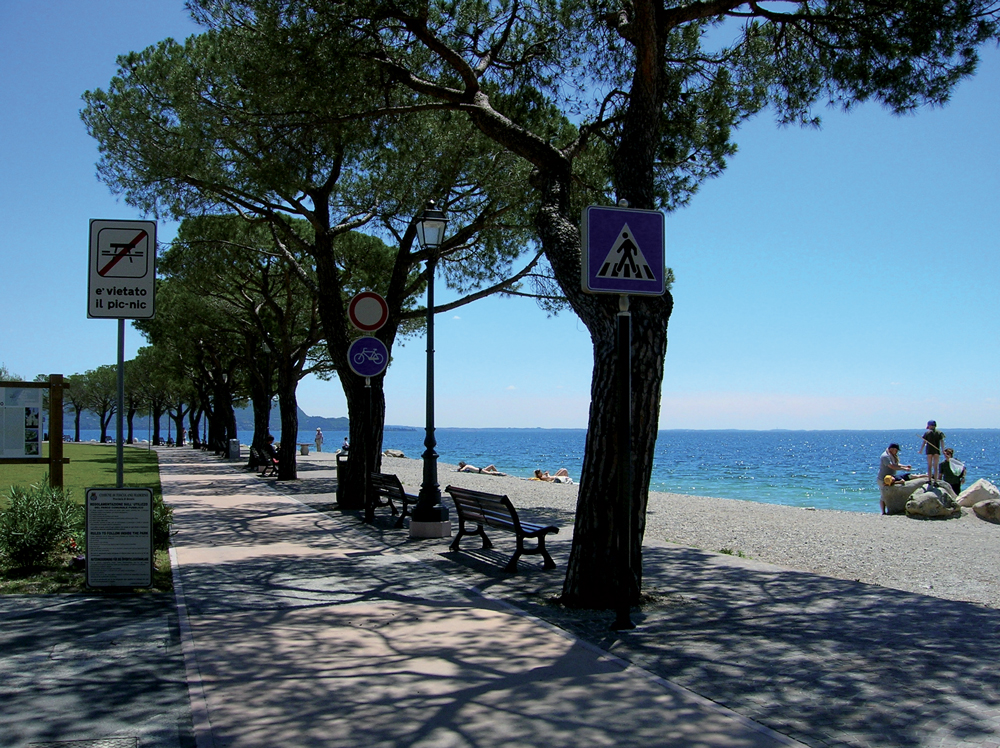
A long and beautiful promenade alongside the lake, from the entrance of Maderno gulf, in Via Roma, up to Lido degli Ulivi in Toscolano. The current lakeside promenade is the result of several roadworks. In 1902 the first part of the promenade was built, in order to allow direct access to the pier'
});
t.setStyle(
new ol.style.Style({
image: new ol.style.Circle({
fill: new ol.style.Fill({
color: 'red'
}),
radius: 8,
stroke: new ol.style.Stroke({
color: '#000000',
width: 1,
}),
}),
}),
);
iconList.push(t);
style['681'] = {
'Point': new ol.style.Style({
image: new ol.style.Circle({
fill: new ol.style.Fill({
color: 'rgba(255,255,0,0.6)',
}),
radius: 10,
stroke: new ol.style.Stroke({
color: '#ff0',
width: 1,
}),
}),
}),
'LineString': new ol.style.Style({
stroke: new ol.style.Stroke({
color: 'red',
width: 3,
}),
}),
'MultiLineString': new ol.style.Style({
stroke: new ol.style.Stroke({
color: 'red',
width: 3,
}),
}),
};
// GPX start
var t = new ol.Feature({
geometry: new ol.geom.Point(ol.proj.fromLonLat([10.610100283346831, 45.65844105677631])),
name: 'Luseti',
description: 'Thanks to the Association “Amici di Luseti”, that restored the ancient paper mill, the building has been converted into a scout camp. The production complex of Luseti had always been one of the biggest in the valley: as early as the second half of 1400s, the presence of several paper mills is documented here. At the end of the 1800s the big buildings extended towards the border with the adjacent locality of Contrada with which it formed a unique area. Going up the trail on the left of the fountain, we find the small church of Luseti entitled to S. Filippo and Giacomo, patron saints of paper makers
WARNING: This part of the Valley is temporarily closed
'
});
t.setStyle(
new ol.style.Style({
image: new ol.style.Circle({
fill: new ol.style.Fill({
color: 'red'
}),
radius: 8,
stroke: new ol.style.Stroke({
color: '#000000',
width: 1,
}),
}),
}),
);
iconList.push(t);
style['682'] = {
'Point': new ol.style.Style({
image: new ol.style.Circle({
fill: new ol.style.Fill({
color: 'rgba(255,255,0,0.6)',
}),
radius: 10,
stroke: new ol.style.Stroke({
color: '#ff0',
width: 1,
}),
}),
}),
'LineString': new ol.style.Style({
stroke: new ol.style.Stroke({
color: 'red',
width: 3,
}),
}),
'MultiLineString': new ol.style.Style({
stroke: new ol.style.Stroke({
color: 'red',
width: 3,
}),
}),
};
// GPX start
var t = new ol.Feature({
geometry: new ol.geom.Point(ol.proj.fromLonLat([10.60472805075, 45.650956671815])),
name: 'Maina di Mezzo',
description: '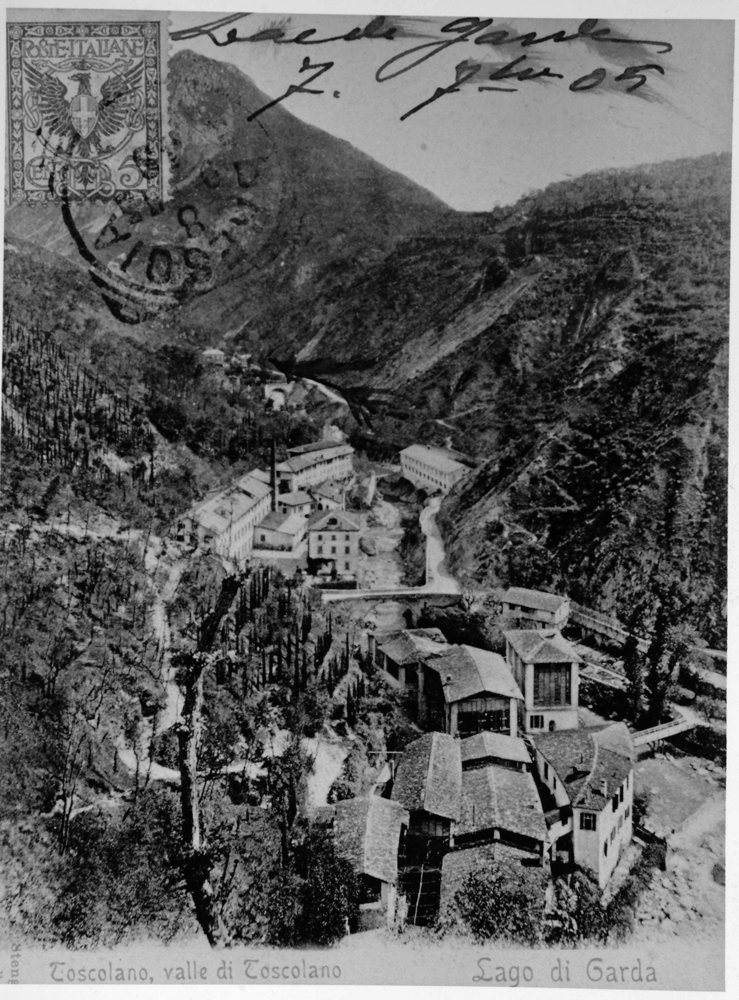
The productive complex of Maina di Mezzo was once connected to Maina Inferiore through a small trail alongside the river, partially visible from the road. Between the end of the 1800s and the beginning of the 1900s there were several buildings, that worked untill the first half of the 1900s. The lush vegetation shows only some of the structures among which the big stone vat stands out. This stone dates back to the XIX Century and it is upon a load-bearing pillar of the factory closer to the river. In 2007 part of one of the buildings in Maina di Mezzo was brought to light thanks to the archaeological excavation by Padova University'
});
t.setStyle(
new ol.style.Style({
image: new ol.style.Circle({
fill: new ol.style.Fill({
color: 'red'
}),
radius: 8,
stroke: new ol.style.Stroke({
color: '#000000',
width: 1,
}),
}),
}),
);
iconList.push(t);
style['684'] = {
'Point': new ol.style.Style({
image: new ol.style.Circle({
fill: new ol.style.Fill({
color: 'rgba(255,255,0,0.6)',
}),
radius: 10,
stroke: new ol.style.Stroke({
color: '#ff0',
width: 1,
}),
}),
}),
'LineString': new ol.style.Style({
stroke: new ol.style.Stroke({
color: 'red',
width: 3,
}),
}),
'MultiLineString': new ol.style.Style({
stroke: new ol.style.Stroke({
color: 'red',
width: 3,
}),
}),
};
// GPX start
var t = new ol.Feature({
geometry: new ol.geom.Point(ol.proj.fromLonLat([10.60418403364, 45.649963002323])),
name: 'Maina Inferiore',
description: '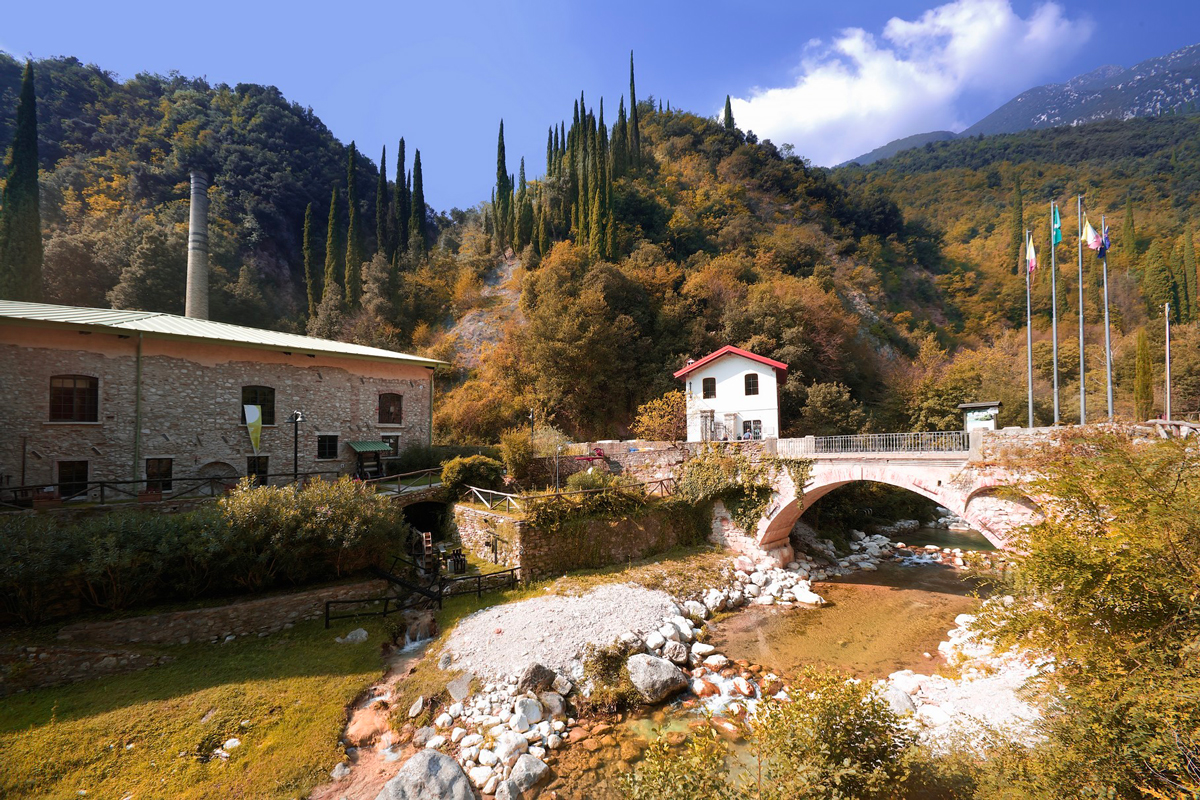
The oldest part of this paper mill dates back to the XV Century, it was then enlarged at the end of the XIX Century.
The paper mill ended its activity in 1962 and it’s now the seat of the Paper Museum since 2007.'
});
t.setStyle(
new ol.style.Style({
image: new ol.style.Circle({
fill: new ol.style.Fill({
color: 'red'
}),
radius: 8,
stroke: new ol.style.Stroke({
color: '#000000',
width: 1,
}),
}),
}),
);
iconList.push(t);
style['683'] = {
'Point': new ol.style.Style({
image: new ol.style.Circle({
fill: new ol.style.Fill({
color: 'rgba(255,255,0,0.6)',
}),
radius: 10,
stroke: new ol.style.Stroke({
color: '#ff0',
width: 1,
}),
}),
}),
'LineString': new ol.style.Style({
stroke: new ol.style.Stroke({
color: 'red',
width: 3,
}),
}),
'MultiLineString': new ol.style.Style({
stroke: new ol.style.Stroke({
color: 'red',
width: 3,
}),
}),
};
// GPX start
var t = new ol.Feature({
geometry: new ol.geom.Point(ol.proj.fromLonLat([10.605365, 45.652391])),
name: 'Maina Superiore',
description: '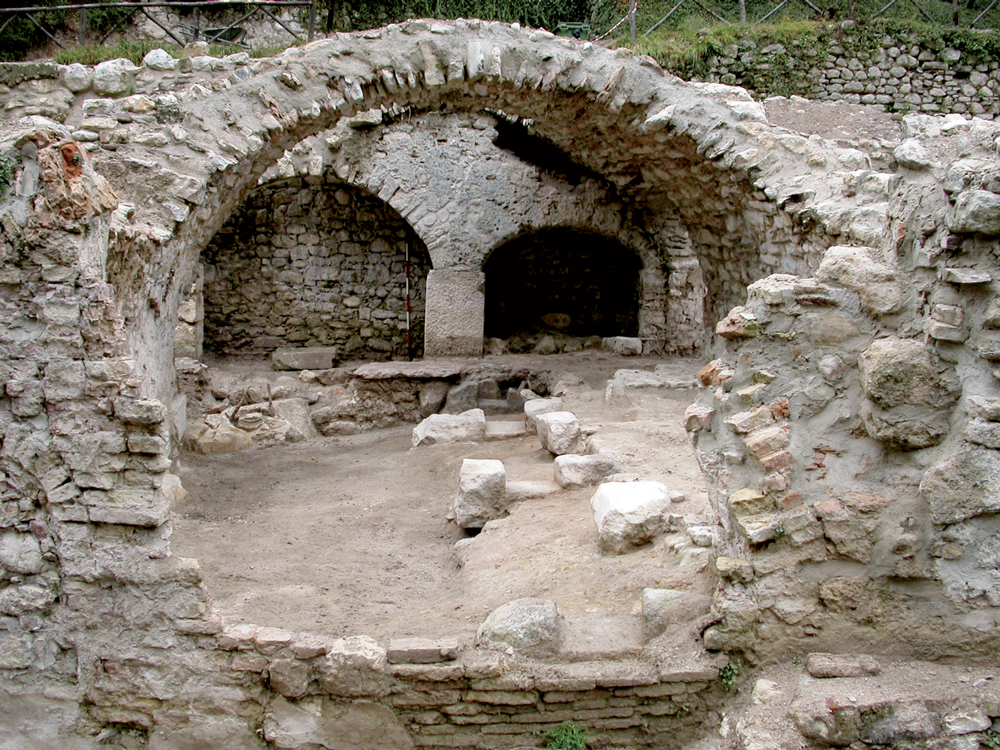
At the end of the XIX Century Maina Superiore was the main productive centre of this area and it represented the heart of a city made of factories, warehouse, channels, houses, gardens and tracks that filled the narrow valley floor. Here is the villa belonged to the Maffizzolis, leading personalities of the industrial development of the valley, and the ruins of their papermill. At the beginning of the XX Century the Maffizzolis abandoned this factory and moved the paper mill by the lake'
});
t.setStyle(
new ol.style.Style({
image: new ol.style.Circle({
fill: new ol.style.Fill({
color: 'red'
}),
radius: 8,
stroke: new ol.style.Stroke({
color: '#000000',
width: 1,
}),
}),
}),
);
iconList.push(t);
style['686'] = {
'Point': new ol.style.Style({
image: new ol.style.Circle({
fill: new ol.style.Fill({
color: 'rgba(255,255,0,0.6)',
}),
radius: 10,
stroke: new ol.style.Stroke({
color: '#ff0',
width: 1,
}),
}),
}),
'LineString': new ol.style.Style({
stroke: new ol.style.Stroke({
color: 'red',
width: 3,
}),
}),
'MultiLineString': new ol.style.Style({
stroke: new ol.style.Stroke({
color: 'red',
width: 3,
}),
}),
};
// GPX start
var t = new ol.Feature({
geometry: new ol.geom.Point(ol.proj.fromLonLat([10.606969, 45.653928])),
name: 'Vago [Vagh/Vach]',
description: '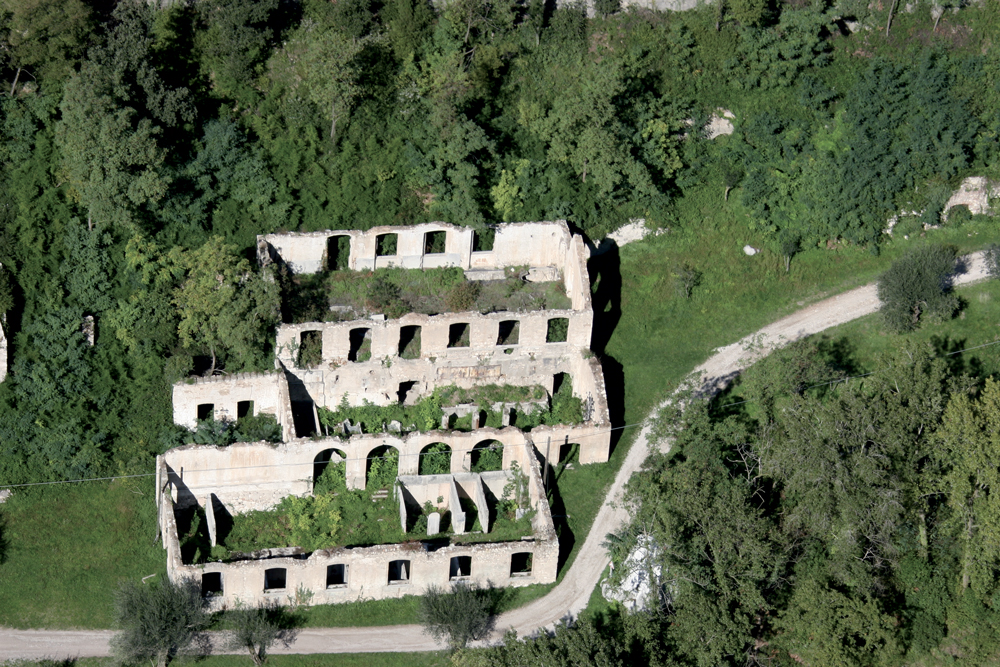
This part of the valley may takes its name from the dialect word vach, that refers to the wet and fresh climate that helped the cultivation of olive trees and grapevines. The first building that we find, with its typical industrial features, dates back to the XIX Century and it still preserves the big tiled tanks of the dutch machine and other concrete tanks that recall the deposit of chimicals used to bleach the pulp. Another building upstream, covered by vegetation, represents the eldest part of the productive complex of Vago.
'
});
t.setStyle(
new ol.style.Style({
image: new ol.style.Circle({
fill: new ol.style.Fill({
color: 'red'
}),
radius: 8,
stroke: new ol.style.Stroke({
color: '#000000',
width: 1,
}),
}),
}),
);
iconList.push(t);
style['687'] = {
'Point': new ol.style.Style({
image: new ol.style.Circle({
fill: new ol.style.Fill({
color: 'rgba(255,255,0,0.6)',
}),
radius: 10,
stroke: new ol.style.Stroke({
color: '#ff0',
width: 1,
}),
}),
}),
'LineString': new ol.style.Style({
stroke: new ol.style.Stroke({
color: 'red',
width: 3,
}),
}),
'MultiLineString': new ol.style.Style({
stroke: new ol.style.Stroke({
color: 'red',
width: 3,
}),
}),
};
// GPX start
var t = new ol.Feature({
geometry: new ol.geom.Point(ol.proj.fromLonLat([10.606623517149, 45.652427455979])),
name: 'Vancinelle',
description: 'Alongside the left bank of the river, the road took to a big building in Vancinelle, also known as Magazzino (warehouse) due to its use, built between 1852 and 1898, opposite to Maina Superiore, to which it was connceted by a bridge. The name of this locality may derives from the vernacular version of the name Avanzini (Vansinèl) who were famous papermills owner.'
});
t.setStyle(
new ol.style.Style({
image: new ol.style.Circle({
fill: new ol.style.Fill({
color: 'red'
}),
radius: 8,
stroke: new ol.style.Stroke({
color: '#000000',
width: 1,
}),
}),
}),
);
iconList.push(t);
var iconLayer = new ol.layer.Vector({
source: new ol.source.Vector({
features: iconList,
}),
});
vectorList_a.push(iconLayer);
var vectorList_25 = [];
var iconList = [];
style['728'] = {
'Point': new ol.style.Style({
image: new ol.style.Circle({
fill: new ol.style.Fill({
color: 'rgba(255,255,0,0.6)',
}),
radius: 10,
stroke: new ol.style.Stroke({
color: '#ff0',
width: 1,
}),
}),
}),
'LineString': new ol.style.Style({
stroke: new ol.style.Stroke({
color: '#ff0000',
width: 3,
}),
}),
'MultiLineString': new ol.style.Style({
stroke: new ol.style.Stroke({
color: '#ff0000',
width: 3,
}),
}),
};
// GPX start
var t = new ol.Feature({
geometry: new ol.geom.Point(ol.proj.fromLonLat([10.60751875636301, 45.631131027445676])),
name: 'Ex Villa Cavallero',
description: 'On the lakeshore of Maderno, it was used by Alessandro Pavolini, Secretary of the new Republican Fascist Party
'
});
t.setStyle(
new ol.style.Style({
image: new ol.style.Circle({
fill: new ol.style.Fill({
color: '#ff0000'
}),
radius: 8,
stroke: new ol.style.Stroke({
color: '#000000',
width: 1,
}),
}),
}),
);
iconList.push(t);
style['743'] = {
'Point': new ol.style.Style({
image: new ol.style.Circle({
fill: new ol.style.Fill({
color: 'rgba(255,255,0,0.6)',
}),
radius: 10,
stroke: new ol.style.Stroke({
color: '#ff0',
width: 1,
}),
}),
}),
'LineString': new ol.style.Style({
stroke: new ol.style.Stroke({
color: '#ff0000',
width: 3,
}),
}),
'MultiLineString': new ol.style.Style({
stroke: new ol.style.Stroke({
color: '#ff0000',
width: 3,
}),
}),
};
// GPX start
var t = new ol.Feature({
geometry: new ol.geom.Point(ol.proj.fromLonLat([10.605147687404417, 45.631533160092985])),
name: 'Hotel Bristol',
description: 'This big building was built at the end of the 1800 and named Villa Margherita. In 1909 became the Strand Hotel Bristol, where kids affected by tubercolosis used to stay during the holidays
Frim 1943 to 1945 was used by Mussolini\'s collaborators
'
});
t.setStyle(
new ol.style.Style({
image: new ol.style.Circle({
fill: new ol.style.Fill({
color: '#ff0000'
}),
radius: 8,
stroke: new ol.style.Stroke({
color: '#000000',
width: 1,
}),
}),
}),
);
iconList.push(t);
style['702'] = {
'Point': new ol.style.Style({
image: new ol.style.Circle({
fill: new ol.style.Fill({
color: 'rgba(255,255,0,0.6)',
}),
radius: 10,
stroke: new ol.style.Stroke({
color: '#ff0',
width: 1,
}),
}),
}),
'LineString': new ol.style.Style({
stroke: new ol.style.Stroke({
color: '#ff0000',
width: 3,
}),
}),
'MultiLineString': new ol.style.Style({
stroke: new ol.style.Stroke({
color: '#ff0000',
width: 3,
}),
}),
};
// GPX start
var t = new ol.Feature({
geometry: new ol.geom.Point(ol.proj.fromLonLat([10.61239851564997, 45.63783494256213])),
name: 'Toscolano Camping',
description: 'The military company of the Italian Social republic was set against the boundary wall, where now there are the tennis courts'
});
t.setStyle(
new ol.style.Style({
image: new ol.style.Circle({
fill: new ol.style.Fill({
color: '#ff0000'
}),
radius: 8,
stroke: new ol.style.Stroke({
color: '#000000',
width: 1,
}),
}),
}),
);
iconList.push(t);
var iconLayer = new ol.layer.Vector({
source: new ol.source.Vector({
features: iconList,
}),
});
vectorList_25.push(iconLayer);
var vectorList_31 = [];
var iconList = [];
style['762'] = {
'Point': new ol.style.Style({
image: new ol.style.Circle({
fill: new ol.style.Fill({
color: 'rgba(255,255,0,0.6)',
}),
radius: 10,
stroke: new ol.style.Stroke({
color: '#ff0',
width: 1,
}),
}),
}),
'LineString': new ol.style.Style({
stroke: new ol.style.Stroke({
color: '#102a47',
width: 3,
}),
}),
'MultiLineString': new ol.style.Style({
stroke: new ol.style.Stroke({
color: '#102a47',
width: 3,
}),
}),
};
// GPX start
var t = new ol.Feature({
geometry: new ol.geom.Point(ol.proj.fromLonLat([10.61957324101857, 45.63935411340573])),
name: 'Garda paragliding',
description: ' '
});
t.setStyle(
new ol.style.Style({
image: new ol.style.Circle({
fill: new ol.style.Fill({
color: '#102a47'
}),
radius: 8,
stroke: new ol.style.Stroke({
color: '#000000',
width: 1,
}),
}),
}),
);
iconList.push(t);
var iconLayer = new ol.layer.Vector({
source: new ol.source.Vector({
features: iconList,
}),
});
vectorList_31.push(iconLayer);
var vectorList_24 = [];
var iconList = [];
style['500'] = {
'Point': new ol.style.Style({
image: new ol.style.Circle({
fill: new ol.style.Fill({
color: 'rgba(255,255,0,0.6)',
}),
radius: 10,
stroke: new ol.style.Stroke({
color: '#ff0',
width: 1,
}),
}),
}),
'LineString': new ol.style.Style({
stroke: new ol.style.Stroke({
color: '#be6acd',
width: 3,
}),
}),
'MultiLineString': new ol.style.Style({
stroke: new ol.style.Stroke({
color: '#be6acd',
width: 3,
}),
}),
};
// GPX start
var t = new ol.Feature({
geometry: new ol.geom.Point(ol.proj.fromLonLat([10.599705474709, 45.635790357945])),
name: 'S. Andrea Cathedral',
description: '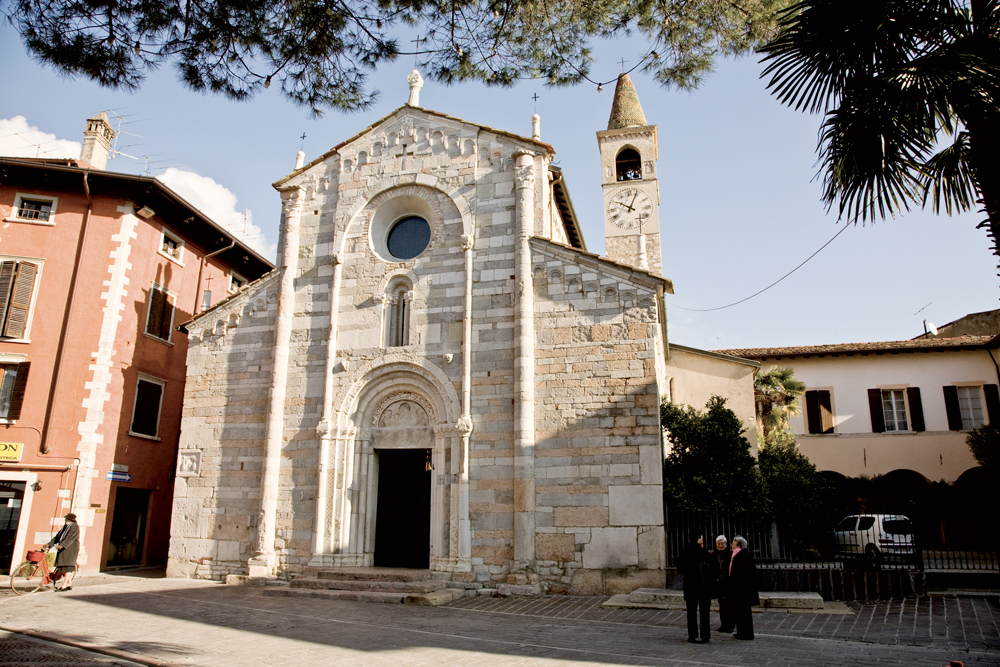
It’s one of the best examples of Lombard-Romanesque architecture influenced by Verona: the façade is masterfully made of stones and polychrome marbles that give light and movement. The inside is divided into 3 aisles by quatrefoil based pillar with capitels representing a wide variety of iconographic decorative motives, typical of the Romanesque style.
Visitors can admire a precious painted board by Paolo Veneziano depicting the Virgin with the Child. The rib vaults of the dom aisles of the chancel date back to the end of the 1400s.
In 1580 Cardinal Borromeo gave the order to close the crypt, that was brought back to light in 1962. Here S. Hercolanus\'s relics were preserved, then moved to the new church in 1825.
'
});
t.setStyle(
new ol.style.Style({
image: new ol.style.Circle({
fill: new ol.style.Fill({
color: '#be6acd'
}),
radius: 8,
stroke: new ol.style.Stroke({
color: '#000000',
width: 1,
}),
}),
}),
);
iconList.push(t);
style['737'] = {
'Point': new ol.style.Style({
image: new ol.style.Circle({
fill: new ol.style.Fill({
color: 'rgba(255,255,0,0.6)',
}),
radius: 10,
stroke: new ol.style.Stroke({
color: '#ff0',
width: 1,
}),
}),
}),
'LineString': new ol.style.Style({
stroke: new ol.style.Stroke({
color: '#be6acd',
width: 3,
}),
}),
'MultiLineString': new ol.style.Style({
stroke: new ol.style.Stroke({
color: '#be6acd',
width: 3,
}),
}),
};
// GPX start
var t = new ol.Feature({
geometry: new ol.geom.Point(ol.proj.fromLonLat([10.599765543738673, 45.63516642642379])),
name: 'S. Andrea\'s Church',
description: '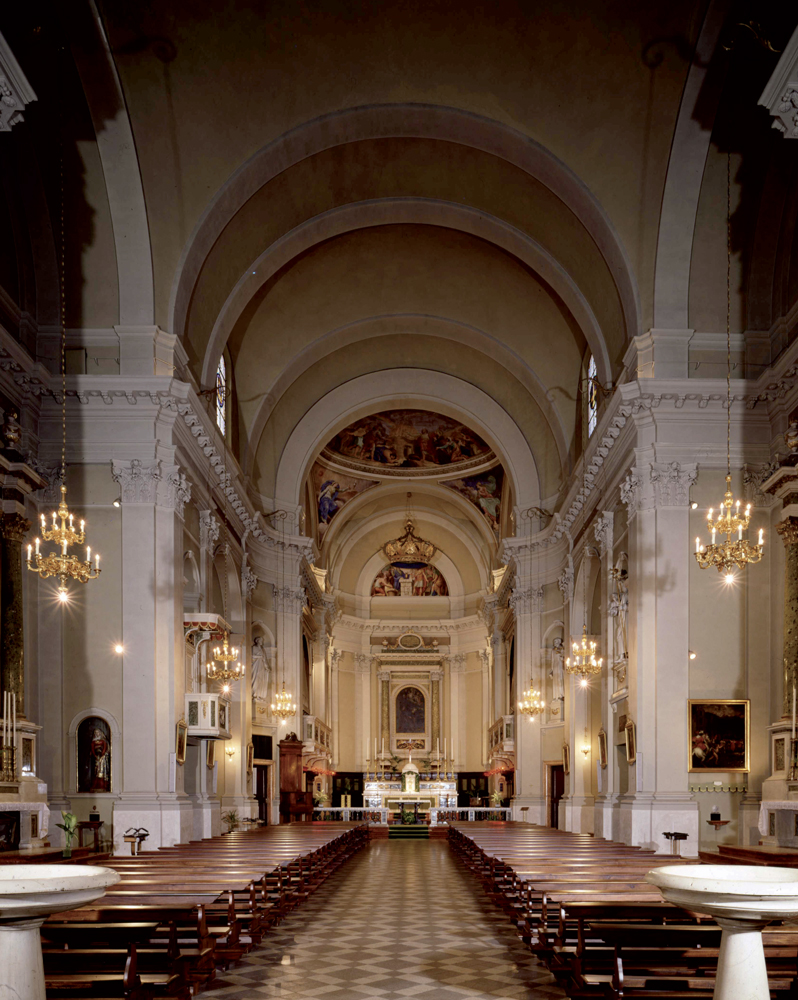
Saint Andrew’s parish church was built during the second half of the XVIII C. where there was once the castle. Its construction was decided in 1742 and it took lots of decades, the church was consacrated in 1825. In this occasion Saint Herculanus’s relics were solemnly moved from the old romanic church to the new parish. The church is a wide building with one aisle. The side chapels, divided by majestic lesenes, have paintings coming from the old parish. On the right side of the aisle there is the altar dedicated to Saint Ercolano that preserves a urne and his relics. The altar is embellished by a painting representing the saint, made by the school of Paolo Caliatri, known as Il Veronese. On the side of the chapel there are two paintings of the beginning of the XVII C. with the Finding of Saint Hercolanus’s body and the Procession of Saint Herculanus’s relics, where it’s possible to recognise the old square with the castle. The altarpiece in the apse represents the Dead Christ with Saint Andrew, made by Francesco Bassano the Young in the second half of the XVI C.'
});
t.setStyle(
new ol.style.Style({
image: new ol.style.Circle({
fill: new ol.style.Fill({
color: '#be6acd'
}),
radius: 8,
stroke: new ol.style.Stroke({
color: '#000000',
width: 1,
}),
}),
}),
);
iconList.push(t);
style['722'] = {
'Point': new ol.style.Style({
image: new ol.style.Circle({
fill: new ol.style.Fill({
color: 'rgba(255,255,0,0.6)',
}),
radius: 10,
stroke: new ol.style.Stroke({
color: '#ff0',
width: 1,
}),
}),
}),
'LineString': new ol.style.Style({
stroke: new ol.style.Stroke({
color: '#be6acd',
width: 3,
}),
}),
'MultiLineString': new ol.style.Style({
stroke: new ol.style.Stroke({
color: '#be6acd',
width: 3,
}),
}),
};
// GPX start
var t = new ol.Feature({
geometry: new ol.geom.Point(ol.proj.fromLonLat([10.600096564629, 45.64535393265])),
name: 'S. Martino\'s Church',
description: '
Close to the district of Sanico, in Prati di San Martino, the small San Martino di Tours’s church was built on an isolated hill near the ravine of the Toscolano river. It was used as lazaretto since the beginning of the 17th Century. The adjacent cemetery hosted the deceased of Maderno and its districts until the end of the 19th Century. It’s a circular church with a rectangular apse. Next to the church there is a small residential building dating back to the 17th Century (see the engraving on the wall) when a hermit used to live here. The original nucleus is the circular building that is now the aisle, and that was supposed to have a small apse east and a pronaos west.'
});
t.setStyle(
new ol.style.Style({
image: new ol.style.Circle({
fill: new ol.style.Fill({
color: '#be6acd'
}),
radius: 8,
stroke: new ol.style.Stroke({
color: '#000000',
width: 1,
}),
}),
}),
);
iconList.push(t);
style['711'] = {
'Point': new ol.style.Style({
image: new ol.style.Circle({
fill: new ol.style.Fill({
color: 'rgba(255,255,0,0.6)',
}),
radius: 10,
stroke: new ol.style.Stroke({
color: '#ff0',
width: 1,
}),
}),
}),
'LineString': new ol.style.Style({
stroke: new ol.style.Stroke({
color: '#be6acd',
width: 3,
}),
}),
'MultiLineString': new ol.style.Style({
stroke: new ol.style.Stroke({
color: '#be6acd',
width: 3,
}),
}),
};
// GPX start
var t = new ol.Feature({
geometry: new ol.geom.Point(ol.proj.fromLonLat([10.616715872936, 45.65003075128])),
name: 'S. Michele\'s Church',
description: '
The old parish church dates back to the 15th Century and it’s right in front of the new parish. Probably built on the ruins of an old fortalice, documented as castellum (castle) in the Middle Ages. San Michele was the main saint for the Longobards. The tower bell looks like a defence tower, at its base there is a “recycled” roman inscription recalling Antoninus Pius and Marcus Aurelius. The portico dates back to the 16th C The church had 3 altars dedicated to San Michele, San Rocco and the Trinity, it was surrounded by a cemetery, a rectory and a rural house. It is now seat of meetings and offices.'
});
t.setStyle(
new ol.style.Style({
image: new ol.style.Circle({
fill: new ol.style.Fill({
color: '#be6acd'
}),
radius: 8,
stroke: new ol.style.Stroke({
color: '#000000',
width: 1,
}),
}),
}),
);
iconList.push(t);
style['712'] = {
'Point': new ol.style.Style({
image: new ol.style.Circle({
fill: new ol.style.Fill({
color: 'rgba(255,255,0,0.6)',
}),
radius: 10,
stroke: new ol.style.Stroke({
color: '#ff0',
width: 1,
}),
}),
}),
'LineString': new ol.style.Style({
stroke: new ol.style.Stroke({
color: '#be6acd',
width: 3,
}),
}),
'MultiLineString': new ol.style.Style({
stroke: new ol.style.Stroke({
color: '#be6acd',
width: 3,
}),
}),
};
// GPX start
var t = new ol.Feature({
geometry: new ol.geom.Point(ol.proj.fromLonLat([10.630855041267, 45.656695606253])),
name: 'S. Nicola\'s Church',
description: '
On the top of a hill in Cecina, it\'s a parish church of medieval origin, restored by Pasino Gozio dei Boselli during the 16th Century. The church was enlarged in 1744 adding 2 side chapels in front of which there are the tombs of the noble Zuanelli family decorated with their emblem.
The one dedicated to the Virgin and the Child is most sumptuous, and it has a fresco of the XV C. with a baroque stucco frame. On the other side, the altar dedicated to Sant’Alipyus with San Dominic and Filippo Neri was made in 1701, and it preserves a painting of Andrea Celesti (1637-1712 ca). Of the same author the altarpiece closer to the presbitery showing the Stoning of Saint Stephen and Virgin in Glory with Saints, John the Baptist, Lucy and Rock .
There is also a portrait representing a young member of the Boselli family praying an image of San Nicola, attributed to Girolamo Pilotti in the 1500s'
});
t.setStyle(
new ol.style.Style({
image: new ol.style.Circle({
fill: new ol.style.Fill({
color: '#be6acd'
}),
radius: 8,
stroke: new ol.style.Stroke({
color: '#000000',
width: 1,
}),
}),
}),
);
iconList.push(t);
style['713'] = {
'Point': new ol.style.Style({
image: new ol.style.Circle({
fill: new ol.style.Fill({
color: 'rgba(255,255,0,0.6)',
}),
radius: 10,
stroke: new ol.style.Stroke({
color: '#ff0',
width: 1,
}),
}),
}),
'LineString': new ol.style.Style({
stroke: new ol.style.Stroke({
color: '#be6acd',
width: 3,
}),
}),
'MultiLineString': new ol.style.Style({
stroke: new ol.style.Stroke({
color: '#be6acd',
width: 3,
}),
}),
};
// GPX start
var t = new ol.Feature({
geometry: new ol.geom.Point(ol.proj.fromLonLat([10.614396139027365, 45.65462032356168])),
name: 'S. Sebastiano\'s Church',
description: '
It’s a small church in the middle of Gaino. There aren’t info about the period of its construction.
San Sebastiano, who protects from contagious diseases, is represented with San Rocco and the Virgin
'
});
t.setStyle(
new ol.style.Style({
image: new ol.style.Circle({
fill: new ol.style.Fill({
color: '#be6acd'
}),
radius: 8,
stroke: new ol.style.Stroke({
color: '#000000',
width: 1,
}),
}),
}),
);
iconList.push(t);
style['724'] = {
'Point': new ol.style.Style({
image: new ol.style.Circle({
fill: new ol.style.Fill({
color: 'rgba(255,255,0,0.6)',
}),
radius: 10,
stroke: new ol.style.Stroke({
color: '#ff0',
width: 1,
}),
}),
}),
'LineString': new ol.style.Style({
stroke: new ol.style.Stroke({
color: '#be6acd',
width: 3,
}),
}),
'MultiLineString': new ol.style.Style({
stroke: new ol.style.Stroke({
color: '#be6acd',
width: 3,
}),
}),
};
// GPX start
var t = new ol.Feature({
geometry: new ol.geom.Point(ol.proj.fromLonLat([10.612592, 45.633150])),
name: 'Santa Maria Immacolata al Promontorio\'s Church',
description: '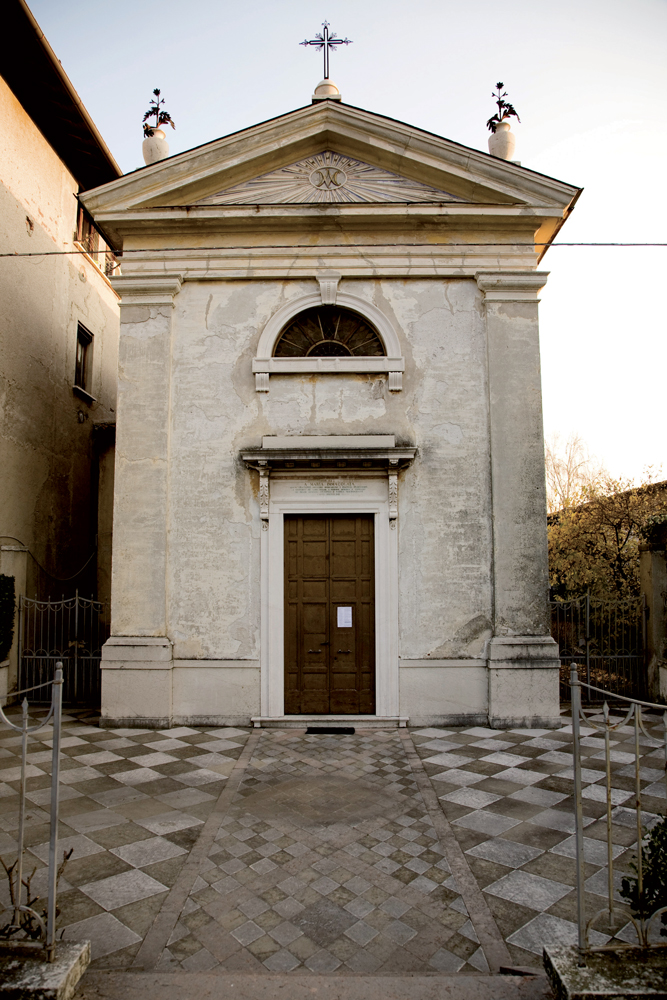
Small oratory, property of the Bonaspetti family. it was built in 1863 by the Franceschini. brothers to commemorate their parents Antonio and Santina
Above the altar, the Virgin with st. Antonio and St. Santina painted by Francesco Podesti
'
});
t.setStyle(
new ol.style.Style({
image: new ol.style.Circle({
fill: new ol.style.Fill({
color: '#be6acd'
}),
radius: 8,
stroke: new ol.style.Stroke({
color: '#000000',
width: 1,
}),
}),
}),
);
iconList.push(t);
style['714'] = {
'Point': new ol.style.Style({
image: new ol.style.Circle({
fill: new ol.style.Fill({
color: 'rgba(255,255,0,0.6)',
}),
radius: 10,
stroke: new ol.style.Stroke({
color: '#ff0',
width: 1,
}),
}),
}),
'LineString': new ol.style.Style({
stroke: new ol.style.Stroke({
color: '#be6acd',
width: 3,
}),
}),
'MultiLineString': new ol.style.Style({
stroke: new ol.style.Stroke({
color: '#be6acd',
width: 3,
}),
}),
};
// GPX start
var t = new ol.Feature({
geometry: new ol.geom.Point(ol.proj.fromLonLat([10.618391662415, 45.64467700808])),
name: 'Santuario di Santa Maria del Benaco',
description: '
The small Church situated at the back of the parish is dedicated to Santa Maria del Benaco and it boasts very ancient origins. The existing plant, which is rectangular with a single nave, dates back to the XV century. If the external appearance is poor and without decorations, the inside is full of beautiful frescoes dating back to the second half of the 15th century and completed in 1514, representing emblems of the important families that contributed to the restoration of the church and were buried here.
The four columns in the middle of the parvis were part of a medieval or romanic ciborium demolished in 1580 by order of Carlo Borromeo, because the main altar had a pagan capitel representing Jupiter Ammon
During the restoration works in 1829 a mosaic floo came to light, probably it belonged to the Roman Villa
'
});
t.setStyle(
new ol.style.Style({
image: new ol.style.Circle({
fill: new ol.style.Fill({
color: '#be6acd'
}),
radius: 8,
stroke: new ol.style.Stroke({
color: '#000000',
width: 1,
}),
}),
}),
);
iconList.push(t);
style['731'] = {
'Point': new ol.style.Style({
image: new ol.style.Circle({
fill: new ol.style.Fill({
color: 'rgba(255,255,0,0.6)',
}),
radius: 10,
stroke: new ol.style.Stroke({
color: '#ff0',
width: 1,
}),
}),
}),
'LineString': new ol.style.Style({
stroke: new ol.style.Stroke({
color: '#be6acd',
width: 3,
}),
}),
'MultiLineString': new ol.style.Style({
stroke: new ol.style.Stroke({
color: '#be6acd',
width: 3,
}),
}),
};
// GPX start
var t = new ol.Feature({
geometry: new ol.geom.Point(ol.proj.fromLonLat([10.591159272696974, 45.63441476270746])),
name: 'St Faustino and St Giovita\'s Church',
description: '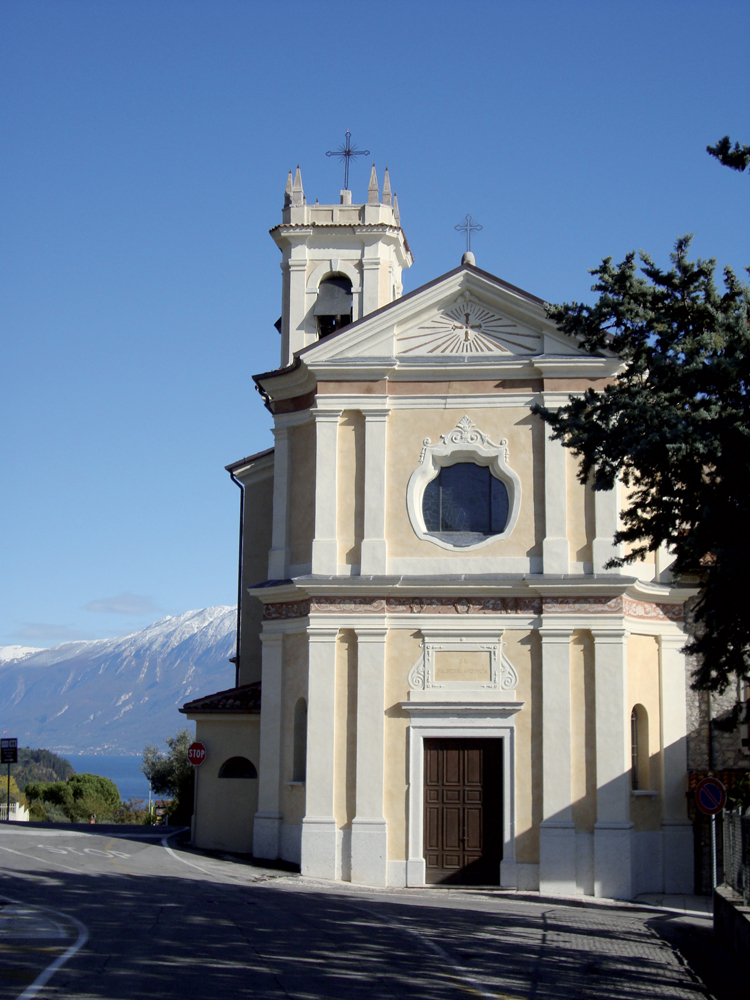
The eighteenth C. Church in Maclino has a unique aisle. The facade is horizontally divided by a gypsum belt course, vertically by twin lesenes supporting the gable. Inside, two side chapels with wooden altars dedicated to the Sacred Heart and to Our Lady of the Rosary. The last one preserves an altarpiece made by Andrea Bertanza from Salò in 1626, it represents the Virgin with Saints Macario and Felicita. On the left of the presbitery there is the canvas of the same author representing the Virgin and the Child with San Carlo Borromeo, Saint Andrew, Saint Herculanus and a benefactor.'
});
t.setStyle(
new ol.style.Style({
image: new ol.style.Circle({
fill: new ol.style.Fill({
color: '#be6acd'
}),
radius: 8,
stroke: new ol.style.Stroke({
color: '#000000',
width: 1,
}),
}),
}),
);
iconList.push(t);
style['706'] = {
'Point': new ol.style.Style({
image: new ol.style.Circle({
fill: new ol.style.Fill({
color: 'rgba(255,255,0,0.6)',
}),
radius: 10,
stroke: new ol.style.Stroke({
color: '#ff0',
width: 1,
}),
}),
}),
'LineString': new ol.style.Style({
stroke: new ol.style.Stroke({
color: '#be6acd',
width: 3,
}),
}),
'MultiLineString': new ol.style.Style({
stroke: new ol.style.Stroke({
color: '#be6acd',
width: 3,
}),
}),
};
// GPX start
var t = new ol.Feature({
geometry: new ol.geom.Point(ol.proj.fromLonLat([10.645940182339, 45.66563927187])),
name: 'St. George\'s Church',
description: '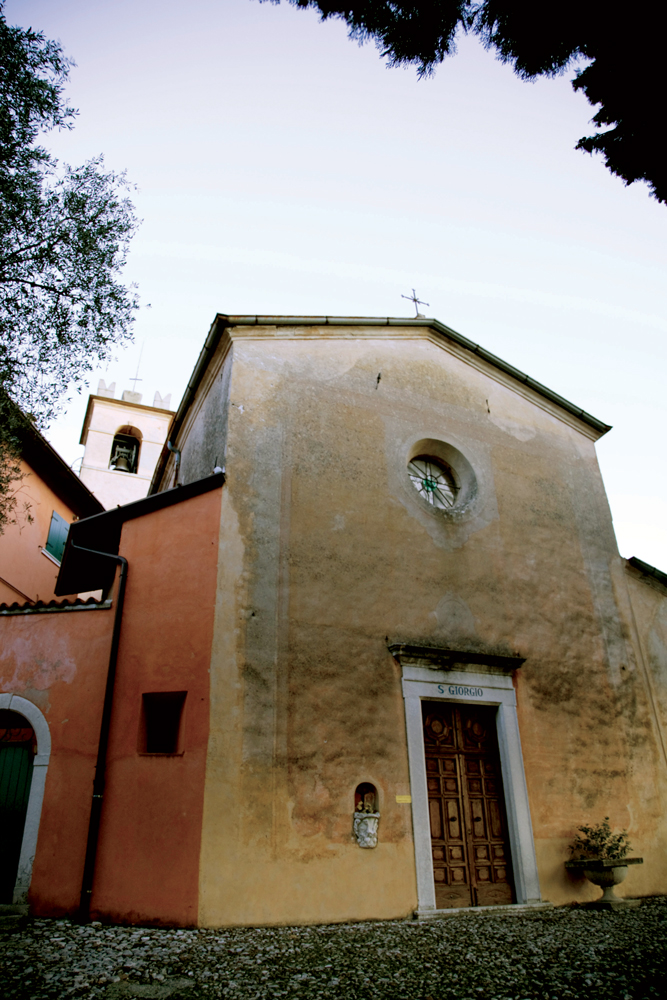
Saint George’s church was founded during the Middle Age, along the ancient royal road, on the top of a hill where the castle of the Pellicani must have been. The façade has a roman corinthian capital. In the apse of the XV C. there is the altarpiece with Saint George slaying the dragon painted by Nicola Grisiani, from Salò, around 1646/47 and a fine altar with polychrome marbles. Under the mensa (tabletop) of the altar there is a roman epigraph dedicated to Lorenia Mercatilla. There are two side altars, one preserves the fine altarpiece with Andrea Celesti’s Piety. The facade of the church was redone during the XVIII C. and completed in 1752 (see the date on the façade). The whole aisle has been repainted during the XX C.'
});
t.setStyle(
new ol.style.Style({
image: new ol.style.Circle({
fill: new ol.style.Fill({
color: '#be6acd'
}),
radius: 8,
stroke: new ol.style.Stroke({
color: '#000000',
width: 1,
}),
}),
}),
);
iconList.push(t);
style['705'] = {
'Point': new ol.style.Style({
image: new ol.style.Circle({
fill: new ol.style.Fill({
color: 'rgba(255,255,0,0.6)',
}),
radius: 10,
stroke: new ol.style.Stroke({
color: '#ff0',
width: 1,
}),
}),
}),
'LineString': new ol.style.Style({
stroke: new ol.style.Stroke({
color: '#be6acd',
width: 3,
}),
}),
'MultiLineString': new ol.style.Style({
stroke: new ol.style.Stroke({
color: '#be6acd',
width: 3,
}),
}),
};
// GPX start
var t = new ol.Feature({
geometry: new ol.geom.Point(ol.proj.fromLonLat([10.617672904071, 45.644477614539])),
name: 'St. Peter and St. Paul\'s Church',
description: '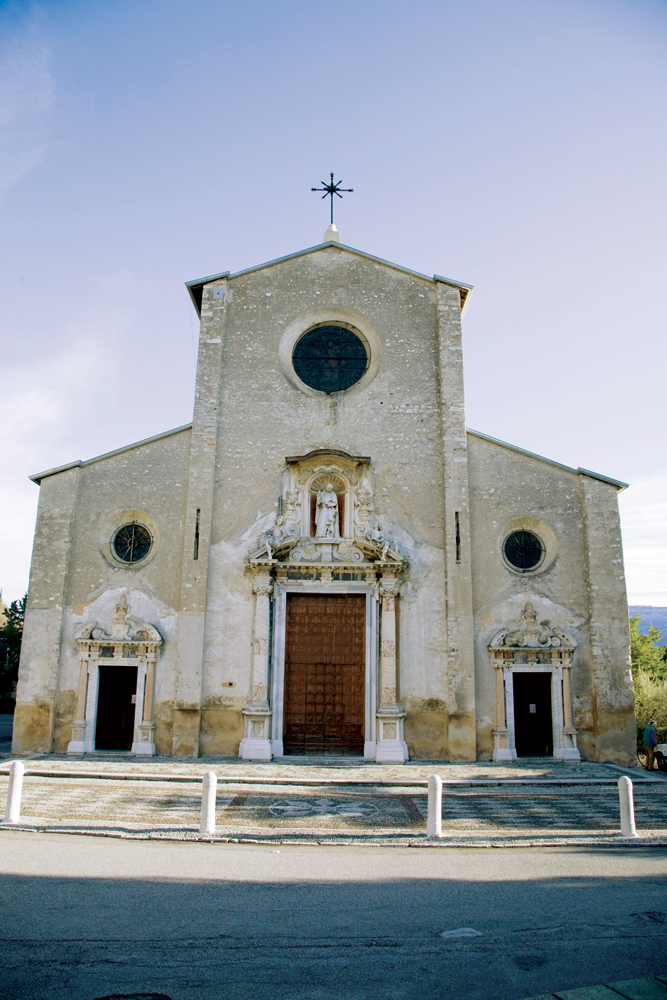
Built in 1584 on the ruins of an old parish church. The austere façade, realized during the XVII Century decorated with two S. Peter statues and two angels, elaborate marble columns, the main two coming from the adjacent Roman Villa. The inside of the church is a proper art gallery with canvases painted by Andrea Celesti between 1688 and the first decade of the 18th Century, depicting S. Peter and Paul’s life. Andrea Celesti relized also the fresco in the apse and in the presbytery, for this reason known as Celest’s Sistine Chapel. There are a lot of tombstones on the floor belonging to the most important families that made the history of Toscolano between the 16th and 17th Century.'
});
t.setStyle(
new ol.style.Style({
image: new ol.style.Circle({
fill: new ol.style.Fill({
color: '#be6acd'
}),
radius: 8,
stroke: new ol.style.Stroke({
color: '#000000',
width: 1,
}),
}),
}),
);
iconList.push(t);
var iconLayer = new ol.layer.Vector({
source: new ol.source.Vector({
features: iconList,
}),
});
vectorList_24.push(iconLayer);
var vectorList_13 = [];
var iconList = [];
style['715'] = {
'Point': new ol.style.Style({
image: new ol.style.Circle({
fill: new ol.style.Fill({
color: 'rgba(255,255,0,0.6)',
}),
radius: 10,
stroke: new ol.style.Stroke({
color: '#ff0',
width: 1,
}),
}),
}),
'LineString': new ol.style.Style({
stroke: new ol.style.Stroke({
color: 'violet',
width: 3,
}),
}),
'MultiLineString': new ol.style.Style({
stroke: new ol.style.Stroke({
color: 'violet',
width: 3,
}),
}),
};
// GPX start
var t = new ol.Feature({
geometry: new ol.geom.Point(ol.proj.fromLonLat([10.637406903483, 45.66953838257])),
name: 'Shrine of Madonna di Supina',
description: '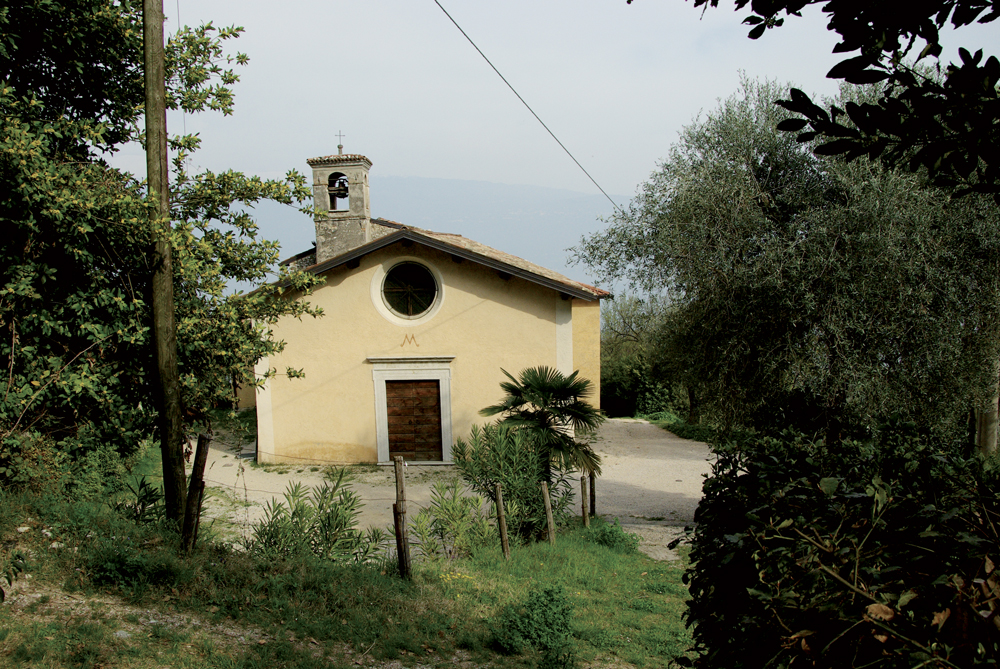
The Madonna di Supina shrine was built at the end of the XV C. by the Toscolano Maderno Municipality. From the second half of the XVI C. the Toscolano community, in order to fulfil a vow, used to have a mass celebrated there every 25th of the month. In 1581 Battista Sgraffignoli left in his will his paper mill in contrada Lupo, in the Papermills Valley, for the celebrations and money to finish the construction of the church and its decoration. As stated in his will, the interior decoration was made between 1583 and 1590 with paintings representing the life of the Virgin and placed between frescoed architectural frames. The statue of the Virgin enthroned in the apse dates back to the half of the XV C, and has a XVII C. wooden altarpiece.
'
});
t.setStyle(
new ol.style.Style({
image: new ol.style.Circle({
fill: new ol.style.Fill({
color: 'violet'
}),
radius: 8,
stroke: new ol.style.Stroke({
color: '#000000',
width: 1,
}),
}),
}),
);
iconList.push(t);
var iconLayer = new ol.layer.Vector({
source: new ol.source.Vector({
features: iconList,
}),
});
vectorList_13.push(iconLayer);
var vectorList_26 = [];
var iconList = [];
style['707'] = {
'Point': new ol.style.Style({
image: new ol.style.Circle({
fill: new ol.style.Fill({
color: 'rgba(255,255,0,0.6)',
}),
radius: 10,
stroke: new ol.style.Stroke({
color: '#ff0',
width: 1,
}),
}),
}),
'LineString': new ol.style.Style({
stroke: new ol.style.Stroke({
color: '#3aa25f',
width: 3,
}),
}),
'MultiLineString': new ol.style.Style({
stroke: new ol.style.Stroke({
color: '#3aa25f',
width: 3,
}),
}),
};
// GPX start
var t = new ol.Feature({
geometry: new ol.geom.Point(ol.proj.fromLonLat([10.604170415888738, 45.64972537665636])),
name: 'The Paper Museum',
description: '
The paper production centre in Maina Inferiore is a fascinating productive complex transformed in museum. The museum recalls the different phases of paper production from the Middle age to the 20th Century, through an evocative path from the 16th Century nucleus of the mill, where visitors find reproductions of machinery and instruments typical of paper production from 15th to 18th Century to the upper rooms dedicated to the evolution of paper production during the early phases of the Industrial Revolution. In exhibition there are also some findings from the archaeological excavations carried out in the Paper Mill Valley, some watermarks produced between the 16th and 18th Century, and a collection of books printed by the Paganinis, illustrious publishers who owned a print shop in Toscolano and Venice during the first half of the 16th Century. Besides guided tours and didactic workshops about the history of paper, The Centre organises cultural events and exhibitions.
Info
www.valledellecartiere.it '
});
t.setStyle(
new ol.style.Style({
image: new ol.style.Circle({
fill: new ol.style.Fill({
color: '#3aa25f'
}),
radius: 8,
stroke: new ol.style.Stroke({
color: '#000000',
width: 1,
}),
}),
}),
);
iconList.push(t);
style['717'] = {
'Point': new ol.style.Style({
image: new ol.style.Circle({
fill: new ol.style.Fill({
color: 'rgba(255,255,0,0.6)',
}),
radius: 10,
stroke: new ol.style.Stroke({
color: '#ff0',
width: 1,
}),
}),
}),
'LineString': new ol.style.Style({
stroke: new ol.style.Stroke({
color: '#3aa25f',
width: 3,
}),
}),
'MultiLineString': new ol.style.Style({
stroke: new ol.style.Stroke({
color: '#3aa25f',
width: 3,
}),
}),
};
// GPX start
var t = new ol.Feature({
geometry: new ol.geom.Point(ol.proj.fromLonLat([10.61828302752718, 45.643419392202766])),
name: 'The Roman Villa',
description: '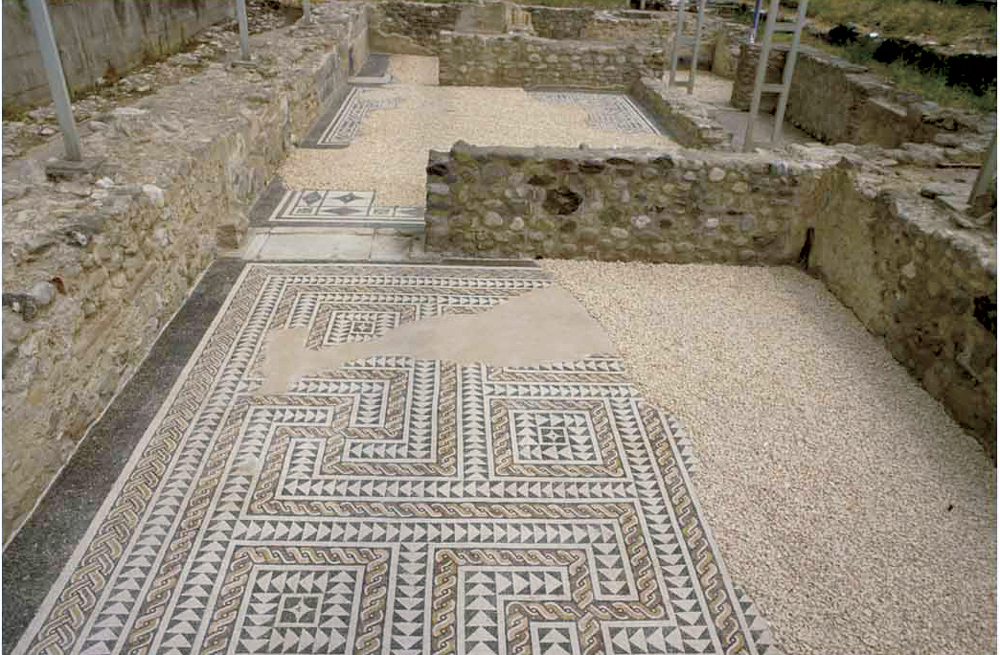
One of the most important residential building of the Lake Garda shore built during the roman period. The main part of the complex faced the lake. Due to the plan, the size, the architectural and decorative features, it is part of the lake villas that once existed on the Benacus shore, like the villa in Sirmione and Desenzano del Garda.
The villa probably belonged to the Nonii, one of the mos important brescian families that had a lot of economic business and properties in the lake and country area. Thanks to an inscription the Villa is attributed toMarcus Nonius Macrinus, consul in 154, proconsul of Asia in 170-171, legatus and comes for the Emperor Marcus Aurelius. The sector that is currently visible it’s th southern one, called sector A, that was one of the side wing of the building. Here are several rooms, some of them with mosaic floors and up to 1 m high painted walls.
Opening times: May - September on saturday and sunday (10-12, 3pm-6pm). Free entry
Info 0365-546023'
});
t.setStyle(
new ol.style.Style({
image: new ol.style.Circle({
fill: new ol.style.Fill({
color: '#3aa25f'
}),
radius: 8,
stroke: new ol.style.Stroke({
color: '#000000',
width: 1,
}),
}),
}),
);
iconList.push(t);
var iconLayer = new ol.layer.Vector({
source: new ol.source.Vector({
features: iconList,
}),
});
vectorList_26.push(iconLayer);
var vectorList_34 = [];
var iconList = [];
style['758'] = {
'Point': new ol.style.Style({
image: new ol.style.Circle({
fill: new ol.style.Fill({
color: 'rgba(255,255,0,0.6)',
}),
radius: 10,
stroke: new ol.style.Stroke({
color: '#ff0',
width: 1,
}),
}),
}),
'LineString': new ol.style.Style({
stroke: new ol.style.Stroke({
color: '#2e6961',
width: 3,
}),
}),
'MultiLineString': new ol.style.Style({
stroke: new ol.style.Stroke({
color: '#2e6961',
width: 3,
}),
}),
};
// GPX start
var t = new ol.Feature({
geometry: new ol.geom.Point(ol.proj.fromLonLat([10.617759927526969, 45.63628861711289])),
name: 'Toscolano Maderno sailing club',
description: 'www.cvtmaderno.com
E-mail: info@scuolavelacvtm.it
'
});
t.setStyle(
new ol.style.Style({
image: new ol.style.Circle({
fill: new ol.style.Fill({
color: '#2e6961'
}),
radius: 8,
stroke: new ol.style.Stroke({
color: '#000000',
width: 1,
}),
}),
}),
);
iconList.push(t);
var iconLayer = new ol.layer.Vector({
source: new ol.source.Vector({
features: iconList,
}),
});
vectorList_34.push(iconLayer);
// PUNTI end ************************************************************************************
var view = new ol.View({
center: ol.proj.transform([10.600677, 45.648558], 'EPSG:4326', 'EPSG:3857'),
//maxZoom: 18,
zoom: 14
})
var map = new ol.Map({
//controls: ol.control.defaults().extend([new ol.control.FullScreen()]),
target: 'map',
overlays: [overlay],
layers: [
// LAYOUT DELLA CARTINA
new ol.layer.Group({
title: 'Show', // A layer must have a title to appear in the layerswitcher
layers: [
new ol.layer.Group({
title: 'Terrain', // A layer must have a title to appear in the layerswitcher
type: 'base', // Setting the layers type to 'base' results in it having a radio button and only one base layer being visibile at a time
combine: true, // Setting combine to true causes sub-layers to be hidden in the layerswitcher, only the parent is shown
visible: false,
layers: [
new ol.layer.Tile({
source: new ol.source.Stamen({
layer: 'terrain'
})
})
]
}),
new ol.layer.Tile({
title: 'Elevation contour lines',
type: 'base',
source: new ol.source.XYZ({
attributions: 'Tiles © ArcGIS',
url: 'https://server.arcgisonline.com/ArcGIS/rest/services/World_Topo_Map/MapServer/tile/{z}/{y}/{x}',
}),
}),
new ol.layer.Tile({
title: 'Satellite',
type: 'base',
source: new ol.source.XYZ({
attributions: 'Tiles © Esri — Source: Esri, i-cubed, USDA, USGS, AEX, GeoEye, Getmapping, Aerogrid, IGN, IGP, UPR-EGP, and the GIS User Community',
url: 'https://server.arcgisonline.com/ArcGIS/rest/services/World_Imagery/MapServer/tile/{z}/{y}/{x}.jpg',
maxZoom: 19,
}),
}),
new ol.layer.Tile({
title: 'Map', // A layer must have a title to appear in the layerswitcher
type: 'base', // Again set this layer as a base layer
visible: true,
source: new ol.source.OSM()
}),
]
}),
new ol.layer.Group({
title: 'Medium Trail',
fold: 'open', // Adding a 'fold' property set to either 'open' or 'close' makes the group layer collapsible
layers: [
new ol.layer.Group({
title: '•
GPS TRACK',
layers: vectorList_38
}),
new ol.layer.Group({
title: '•
FISHING',
layers: vectorList_28
}),
new ol.layer.Group({
title: '•
MONUMENTS',
layers: vectorList_16
}),
new ol.layer.Group({
title: '•
ROWING',
layers: vectorList_36
}),
new ol.layer.Group({
title: '•
CULTURAL SITE',
layers: vectorList_23
}),
new ol.layer.Group({
title: '•
VILLAS AND PALACES',
layers: vectorList_27
}),
new ol.layer.Group({
title: '•
GOLF',
layers: vectorList_35
}),
new ol.layer.Group({
title: '•
Altro',
layers: vectorList_a
}),
new ol.layer.Group({
title: '•
ITALIAN SOCIAL REPUBLIC',
layers: vectorList_25
}),
new ol.layer.Group({
title: '•
PARAGLIDING',
layers: vectorList_31
}),
new ol.layer.Group({
title: '•
CHURCHES',
layers: vectorList_24
}),
new ol.layer.Group({
title: '•
CULT',
layers: vectorList_13
}),
new ol.layer.Group({
title: '•
MUSEUMS AND PARKS',
layers: vectorList_26
}),
new ol.layer.Group({
title: '•
SAILING',
layers: vectorList_34
}),
]
}),
],
view: view,
});
// GEOLOCALIZZAZIONE start ************************************************************************************
var geolocation = new ol.Geolocation({
// enableHighAccuracy must be set to true to have the heading value.
trackingOptions: {
enableHighAccuracy: true,
},
projection: view.getProjection(),
});
function el(id) {
return document.getElementById(id);
}
el('track').addEventListener('change', function () {
geolocation.setTracking(this.checked);
});
geolocation.on('change', function () {
el('accuracy').innerText = geolocation.getAccuracy() + ' [m]';
el('altitude').innerText = geolocation.getAltitude() + ' [m]';
el('altitudeAccuracy').innerText = geolocation.getAltitudeAccuracy() + ' [m]';
el('heading').innerText = geolocation.getHeading() + ' [rad]';
el('speed').innerText = geolocation.getSpeed() + ' [m/s]';
el('position').innerText = geolocation.getPosition();
});
// handle geolocation error.
geolocation.on('error', function (error) {
var info = document.getElementById('info-track');
info.innerHTML = error.message;
info.style.display = '';
});
var accuracyFeature = new ol.Feature();
geolocation.on('change:accuracyGeometry', function () {
accuracyFeature.setGeometry(geolocation.getAccuracyGeometry());
map.getView().animate({ center: geolocation.getPosition() }, { duration: 750 });
});
var positionFeature = new ol.Feature();
positionFeature.setStyle(
new ol.style.Style({
image: new ol.style.Circle({
radius: 6,
fill: new ol.style.Fill({
color: '#3399CC',
}),
stroke: new ol.style.Stroke({
color: '#fff',
width: 2,
}),
}),
})
);
// geolocation.on('change:position', function () {
geolocation.on('change', function () {
var coordinates = geolocation.getPosition();
positionFeature.setGeometry(coordinates ? new ol.geom.Point(coordinates) : null);
});
new ol.layer.Vector({
map: map,
source: new ol.source.Vector({
features: [accuracyFeature, positionFeature],
}),
});
// GEOLOCALIZZAZIONE end ************************************************************************************
// LINK To POINT start ************************************************************************************
// LINK To POINT end ************************************************************************************
// POPOUP start ************************************************************************************
var element = document.getElementById('popup');
var popup = new ol.Overlay({
element: element,
positioning: 'bottom-center',
stopEvent: false,
offset: [0, 0],
});
map.addOverlay(popup);
map.on('singleclick', function (evt) {
$(element).popover('dispose');
var feature = map.forEachFeatureAtPixel(evt.pixel, function (feature) {
return feature;
});
if (feature) {
var coordinate = evt.coordinate;
var hdms = ol.coordinate.toStringHDMS(ol.proj.toLonLat(coordinate));
content.innerHTML = '' + feature.get('name') + '
' + feature.get('description') + '
' + hdms + '';
overlay.setPosition(coordinate);
}
});
// POPOUP end ************************************************************************************
// Get out-of-the-map div element with the ID "layers" and renders layers to it.
// NOTE: If the layers are changed outside of the layer switcher then you
// will need to call ol.control.LayerSwitcher.renderPanel again to refesh
// the layer tree. Style the tree via CSS.
var sidebar = new ol.control.Sidebar({
element: 'sidebar',
position: 'left'
});
var toc = document.getElementById('layers');
ol.control.LayerSwitcher.renderPanel(map, toc, { reverse: true });
map.addControl(sidebar);
})(); 





















